Report: Assessing Multicultural Workforce Impact on Teamwork at Amazon
VerifiedAdded on 2023/02/03
|23
|5516
|58
Report
AI Summary
This report presents the findings of a study evaluating the impact of a multicultural workforce on teamwork and organizational performance at Amazon, based on a survey of 111 employees in America and China. The research employed a five-point Likert-scale questionnaire to assess employee perspectives on the effects of cultural heterogeneity. Key findings reveal that while the majority of respondents do not believe that working with colleagues from different ethnicities negatively affects their work performance, language barriers and miscommunication were identified as significant challenges. The study also highlights that cultural diversity is generally viewed positively, aiding in finding innovative solutions, while religious heterogeneity does not appear to significantly impact teamwork. The report underscores the complexities of managing a diverse workforce, indicating areas for improvement in communication and the acceptance of diverse ideas to enhance teamwork and overall organizational productivity.
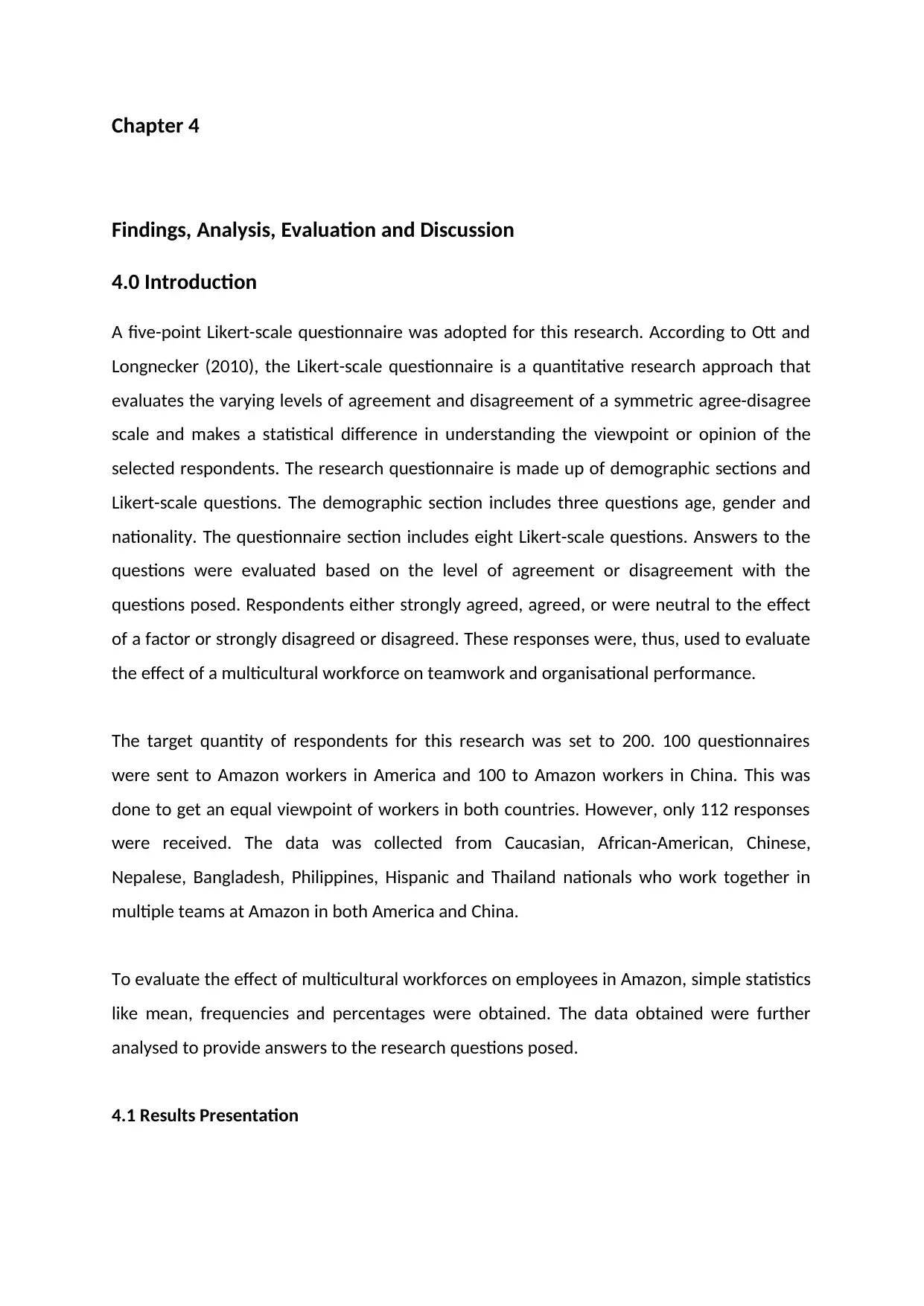
Chapter 4
Findings, Analysis, Evaluation and Discussion
4.0 Introduction
A five-point Likert-scale questionnaire was adopted for this research. According to Ott and
Longnecker (2010), the Likert-scale questionnaire is a quantitative research approach that
evaluates the varying levels of agreement and disagreement of a symmetric agree-disagree
scale and makes a statistical difference in understanding the viewpoint or opinion of the
selected respondents. The research questionnaire is made up of demographic sections and
Likert-scale questions. The demographic section includes three questions age, gender and
nationality. The questionnaire section includes eight Likert-scale questions. Answers to the
questions were evaluated based on the level of agreement or disagreement with the
questions posed. Respondents either strongly agreed, agreed, or were neutral to the effect
of a factor or strongly disagreed or disagreed. These responses were, thus, used to evaluate
the effect of a multicultural workforce on teamwork and organisational performance.
The target quantity of respondents for this research was set to 200. 100 questionnaires
were sent to Amazon workers in America and 100 to Amazon workers in China. This was
done to get an equal viewpoint of workers in both countries. However, only 112 responses
were received. The data was collected from Caucasian, African-American, Chinese,
Nepalese, Bangladesh, Philippines, Hispanic and Thailand nationals who work together in
multiple teams at Amazon in both America and China.
To evaluate the effect of multicultural workforces on employees in Amazon, simple statistics
like mean, frequencies and percentages were obtained. The data obtained were further
analysed to provide answers to the research questions posed.
4.1 Results Presentation
Findings, Analysis, Evaluation and Discussion
4.0 Introduction
A five-point Likert-scale questionnaire was adopted for this research. According to Ott and
Longnecker (2010), the Likert-scale questionnaire is a quantitative research approach that
evaluates the varying levels of agreement and disagreement of a symmetric agree-disagree
scale and makes a statistical difference in understanding the viewpoint or opinion of the
selected respondents. The research questionnaire is made up of demographic sections and
Likert-scale questions. The demographic section includes three questions age, gender and
nationality. The questionnaire section includes eight Likert-scale questions. Answers to the
questions were evaluated based on the level of agreement or disagreement with the
questions posed. Respondents either strongly agreed, agreed, or were neutral to the effect
of a factor or strongly disagreed or disagreed. These responses were, thus, used to evaluate
the effect of a multicultural workforce on teamwork and organisational performance.
The target quantity of respondents for this research was set to 200. 100 questionnaires
were sent to Amazon workers in America and 100 to Amazon workers in China. This was
done to get an equal viewpoint of workers in both countries. However, only 112 responses
were received. The data was collected from Caucasian, African-American, Chinese,
Nepalese, Bangladesh, Philippines, Hispanic and Thailand nationals who work together in
multiple teams at Amazon in both America and China.
To evaluate the effect of multicultural workforces on employees in Amazon, simple statistics
like mean, frequencies and percentages were obtained. The data obtained were further
analysed to provide answers to the research questions posed.
4.1 Results Presentation
Secure Best Marks with AI Grader
Need help grading? Try our AI Grader for instant feedback on your assignments.

To evaluate the effect of cultural heterogeneity on teamwork and organisational
performance, mean, frequencies and percentages were obtained. The higher the value of
mean, frequencies and percentages, the stronger the effect of the factor on teamwork and
overall organisational performance. The mean, frequencies and percentages of
demographics are shown in pie charts 1, 2 and 3 and of questions are shown in table 1.
The data obtained from the questionnaire indicate that from the 111 Amazon employees
who responded to the questionnaire, the gender response was 57 males (51%) and 54
females (49%). The majority of the respondents belonged to the age group between 31-40,
this group comprised a response rate of 45%, followed by 25.22% in the age group between
21-30, 15.3% in the age group between 41-50, 12% in the age group between 51-60 and 3%
in the age group between 18-20. Amazon in America and China consists of employees from
various parts of the world; the highest percentage of responses obtained for the research is
16% for both Caucasian and Chinese workers, this is followed by 14% for Hispanic workers,
13% for workers from Bangladesh, 12% for workers from African-American and Nepalese
descent, 11% for workers from Thailand and 7.2% for Philippines workers.
Male
51%
Female
49%
Gender
Male
Female
performance, mean, frequencies and percentages were obtained. The higher the value of
mean, frequencies and percentages, the stronger the effect of the factor on teamwork and
overall organisational performance. The mean, frequencies and percentages of
demographics are shown in pie charts 1, 2 and 3 and of questions are shown in table 1.
The data obtained from the questionnaire indicate that from the 111 Amazon employees
who responded to the questionnaire, the gender response was 57 males (51%) and 54
females (49%). The majority of the respondents belonged to the age group between 31-40,
this group comprised a response rate of 45%, followed by 25.22% in the age group between
21-30, 15.3% in the age group between 41-50, 12% in the age group between 51-60 and 3%
in the age group between 18-20. Amazon in America and China consists of employees from
various parts of the world; the highest percentage of responses obtained for the research is
16% for both Caucasian and Chinese workers, this is followed by 14% for Hispanic workers,
13% for workers from Bangladesh, 12% for workers from African-American and Nepalese
descent, 11% for workers from Thailand and 7.2% for Philippines workers.
Male
51%
Female
49%
Gender
Male
Female

Figure 1: Gender Demographic of Amazon Workers in the Research
45%
15.3%
12%
3%
25.22%
Age
31-40 21-30 41-50 51-60 18-20
Figure 2: Age Demographic of Amazon Workers in the Research
45%
15.3%
12%
3%
25.22%
Age
31-40 21-30 41-50 51-60 18-20
Figure 2: Age Demographic of Amazon Workers in the Research
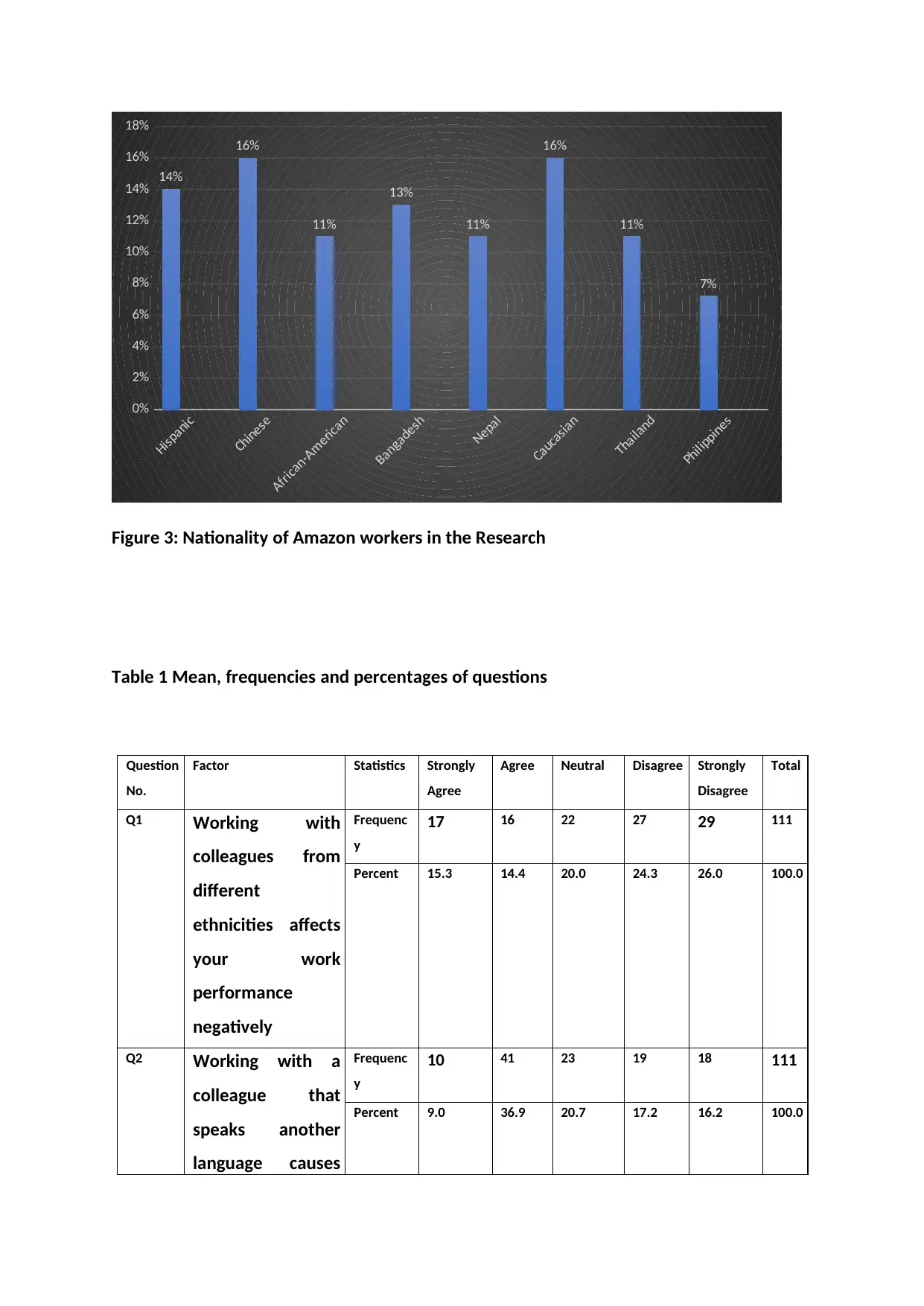
Hispanic
Chinese
African-American
Bangadesh
Nepal
Caucasian
Thailand
Philippines
0%
2%
4%
6%
8%
10%
12%
14%
16%
18%
14%
16%
11%
13%
11%
16%
11%
7%
Figure 3: Nationality of Amazon workers in the Research
Table 1 Mean, frequencies and percentages of questions
Question
No.
Factor Statistics Strongly
Agree
Agree Neutral Disagree Strongly
Disagree
Total
Q1 Working with
colleagues from
different
ethnicities affects
your work
performance
negatively
Frequenc
y
17 16 22 27 29 111
Percent 15.3 14.4 20.0 24.3 26.0 100.0
Q2 Working with a
colleague that
speaks another
language causes
Frequenc
y
10 41 23 19 18 111
Percent 9.0 36.9 20.7 17.2 16.2 100.0
Chinese
African-American
Bangadesh
Nepal
Caucasian
Thailand
Philippines
0%
2%
4%
6%
8%
10%
12%
14%
16%
18%
14%
16%
11%
13%
11%
16%
11%
7%
Figure 3: Nationality of Amazon workers in the Research
Table 1 Mean, frequencies and percentages of questions
Question
No.
Factor Statistics Strongly
Agree
Agree Neutral Disagree Strongly
Disagree
Total
Q1 Working with
colleagues from
different
ethnicities affects
your work
performance
negatively
Frequenc
y
17 16 22 27 29 111
Percent 15.3 14.4 20.0 24.3 26.0 100.0
Q2 Working with a
colleague that
speaks another
language causes
Frequenc
y
10 41 23 19 18 111
Percent 9.0 36.9 20.7 17.2 16.2 100.0
Secure Best Marks with AI Grader
Need help grading? Try our AI Grader for instant feedback on your assignments.

miscommunication
Q3 You easily form
alliances with
people from a
dissimilar race at
work
Frequenc
y
6 12 40 34 19 111
Percent 5.4 10.8 36.0 30.6 17.2 100.0
Q4 Cultural diversity
at the workplace
helps in finding
better ways to do
things
Frequenc
y
11 61 17 9 13 111
Percent 9.9 55.0 15.3 8.1 11.7 100.0
Q5 The presence of
heterogeneous
religious groups in
the organisation
affect teamwork
and productivity
Frequenc
y
10 11 44 32 14 200
Percent 9.0 10.0 39.6 28.8 12.6 100.0
Q6 The presence of a
multicultural
workforce affects
the level of trust
you have for your
colleagues
Frequenc
y
3 10 51 25 22 111
Percent 2.7 9.0 46.0 22.5 19.8 100.0
Q7 The ideas of
people from
different cultural
groups are easily
accepted at work
Frequenc
y
4 20 18 53 16 111
Percent 3.6 18.0 16.0 47.7 14.4 100.0
Q8 You have to work
harder to fit into
your team as a
result of your
Frequenc
y
6 14 52 19 20 111
Percent 5.0 13.0 47.0 17.0 18.0 100.0
Q3 You easily form
alliances with
people from a
dissimilar race at
work
Frequenc
y
6 12 40 34 19 111
Percent 5.4 10.8 36.0 30.6 17.2 100.0
Q4 Cultural diversity
at the workplace
helps in finding
better ways to do
things
Frequenc
y
11 61 17 9 13 111
Percent 9.9 55.0 15.3 8.1 11.7 100.0
Q5 The presence of
heterogeneous
religious groups in
the organisation
affect teamwork
and productivity
Frequenc
y
10 11 44 32 14 200
Percent 9.0 10.0 39.6 28.8 12.6 100.0
Q6 The presence of a
multicultural
workforce affects
the level of trust
you have for your
colleagues
Frequenc
y
3 10 51 25 22 111
Percent 2.7 9.0 46.0 22.5 19.8 100.0
Q7 The ideas of
people from
different cultural
groups are easily
accepted at work
Frequenc
y
4 20 18 53 16 111
Percent 3.6 18.0 16.0 47.7 14.4 100.0
Q8 You have to work
harder to fit into
your team as a
result of your
Frequenc
y
6 14 52 19 20 111
Percent 5.0 13.0 47.0 17.0 18.0 100.0
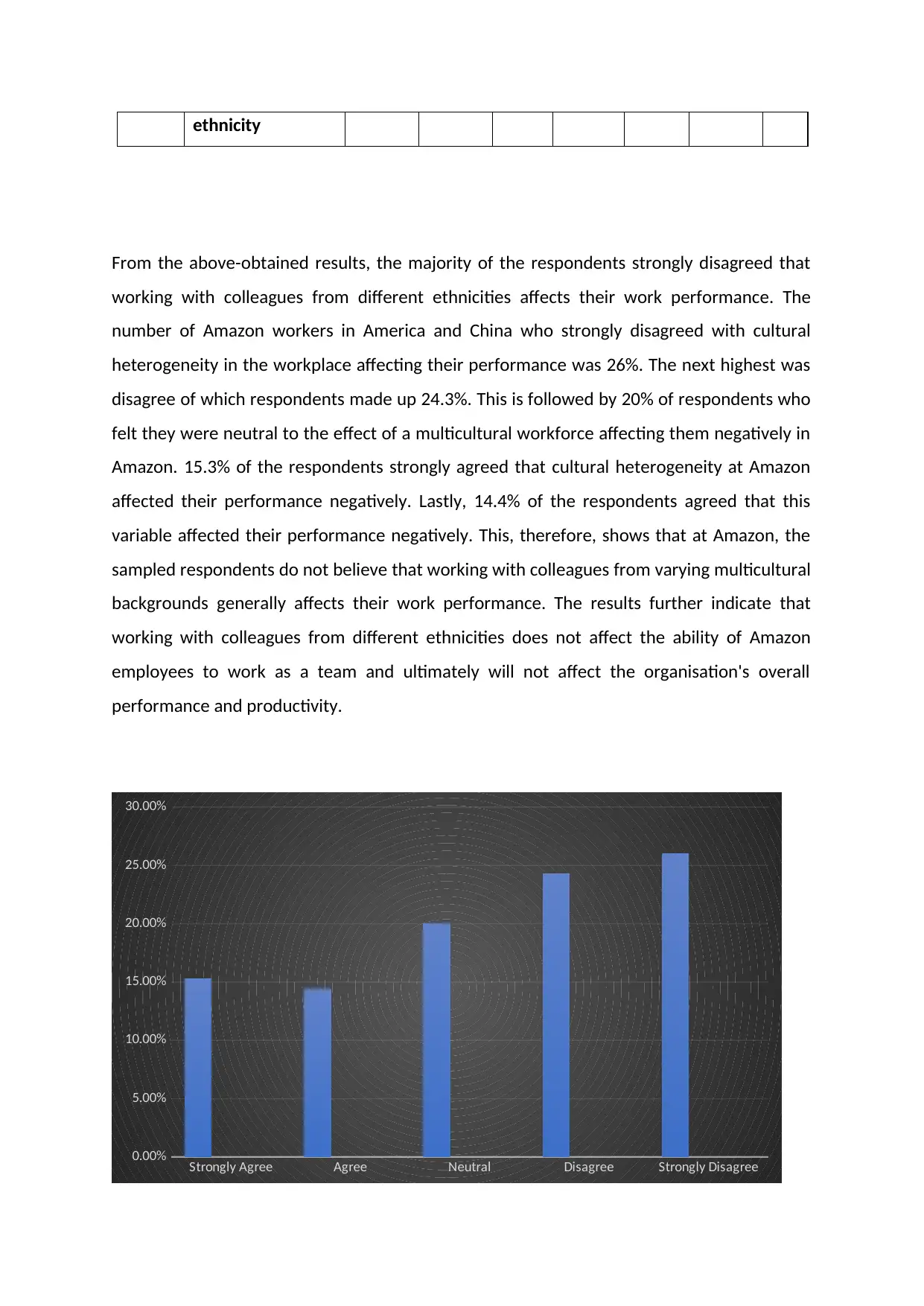
ethnicity
From the above-obtained results, the majority of the respondents strongly disagreed that
working with colleagues from different ethnicities affects their work performance. The
number of Amazon workers in America and China who strongly disagreed with cultural
heterogeneity in the workplace affecting their performance was 26%. The next highest was
disagree of which respondents made up 24.3%. This is followed by 20% of respondents who
felt they were neutral to the effect of a multicultural workforce affecting them negatively in
Amazon. 15.3% of the respondents strongly agreed that cultural heterogeneity at Amazon
affected their performance negatively. Lastly, 14.4% of the respondents agreed that this
variable affected their performance negatively. This, therefore, shows that at Amazon, the
sampled respondents do not believe that working with colleagues from varying multicultural
backgrounds generally affects their work performance. The results further indicate that
working with colleagues from different ethnicities does not affect the ability of Amazon
employees to work as a team and ultimately will not affect the organisation's overall
performance and productivity.
Strongly Agree Agree Neutral Disagree Strongly Disagree
0.00%
5.00%
10.00%
15.00%
20.00%
25.00%
30.00%
From the above-obtained results, the majority of the respondents strongly disagreed that
working with colleagues from different ethnicities affects their work performance. The
number of Amazon workers in America and China who strongly disagreed with cultural
heterogeneity in the workplace affecting their performance was 26%. The next highest was
disagree of which respondents made up 24.3%. This is followed by 20% of respondents who
felt they were neutral to the effect of a multicultural workforce affecting them negatively in
Amazon. 15.3% of the respondents strongly agreed that cultural heterogeneity at Amazon
affected their performance negatively. Lastly, 14.4% of the respondents agreed that this
variable affected their performance negatively. This, therefore, shows that at Amazon, the
sampled respondents do not believe that working with colleagues from varying multicultural
backgrounds generally affects their work performance. The results further indicate that
working with colleagues from different ethnicities does not affect the ability of Amazon
employees to work as a team and ultimately will not affect the organisation's overall
performance and productivity.
Strongly Agree Agree Neutral Disagree Strongly Disagree
0.00%
5.00%
10.00%
15.00%
20.00%
25.00%
30.00%
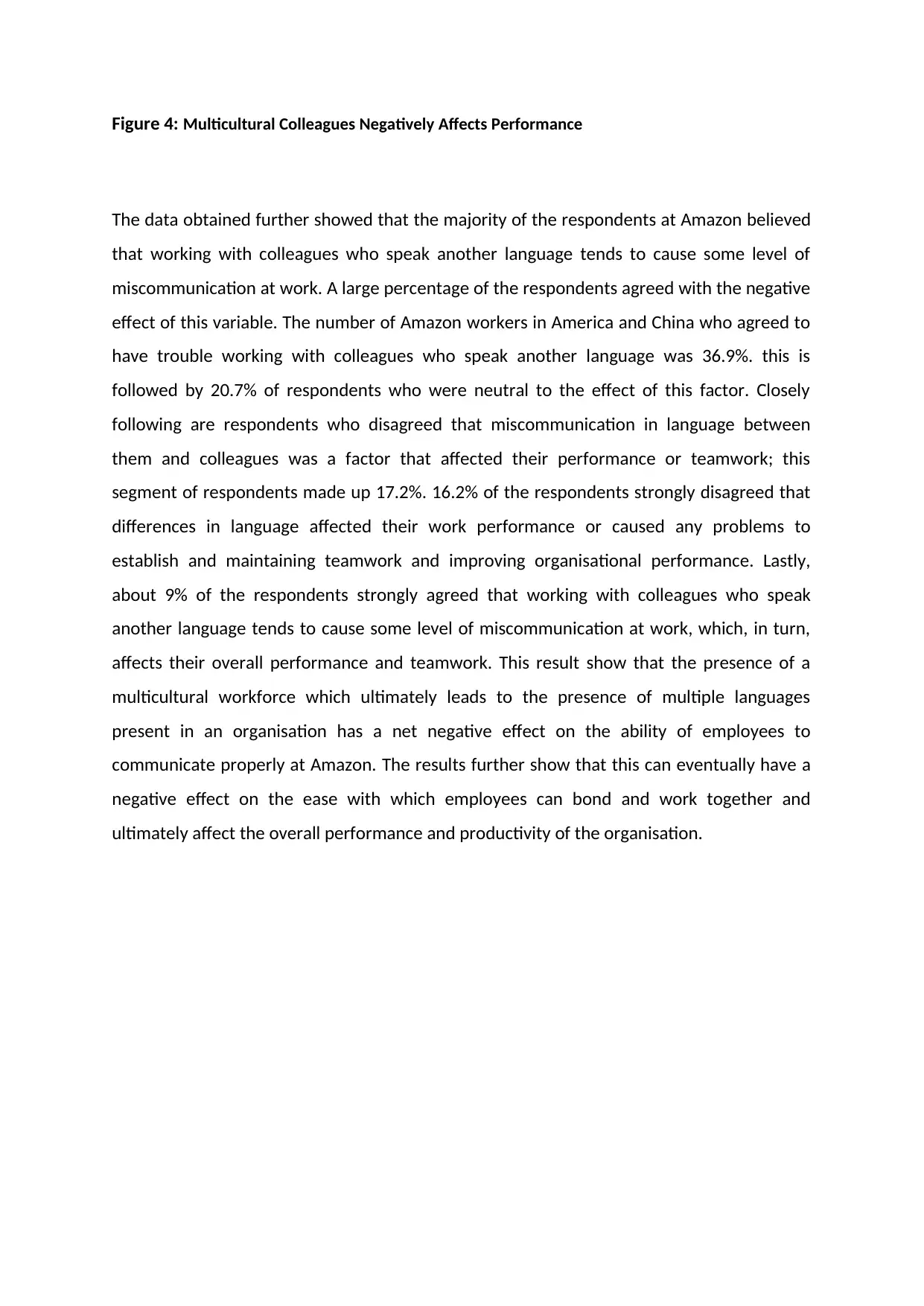
Figure 4: Multicultural Colleagues Negatively Affects Performance
The data obtained further showed that the majority of the respondents at Amazon believed
that working with colleagues who speak another language tends to cause some level of
miscommunication at work. A large percentage of the respondents agreed with the negative
effect of this variable. The number of Amazon workers in America and China who agreed to
have trouble working with colleagues who speak another language was 36.9%. this is
followed by 20.7% of respondents who were neutral to the effect of this factor. Closely
following are respondents who disagreed that miscommunication in language between
them and colleagues was a factor that affected their performance or teamwork; this
segment of respondents made up 17.2%. 16.2% of the respondents strongly disagreed that
differences in language affected their work performance or caused any problems to
establish and maintaining teamwork and improving organisational performance. Lastly,
about 9% of the respondents strongly agreed that working with colleagues who speak
another language tends to cause some level of miscommunication at work, which, in turn,
affects their overall performance and teamwork. This result show that the presence of a
multicultural workforce which ultimately leads to the presence of multiple languages
present in an organisation has a net negative effect on the ability of employees to
communicate properly at Amazon. The results further show that this can eventually have a
negative effect on the ease with which employees can bond and work together and
ultimately affect the overall performance and productivity of the organisation.
The data obtained further showed that the majority of the respondents at Amazon believed
that working with colleagues who speak another language tends to cause some level of
miscommunication at work. A large percentage of the respondents agreed with the negative
effect of this variable. The number of Amazon workers in America and China who agreed to
have trouble working with colleagues who speak another language was 36.9%. this is
followed by 20.7% of respondents who were neutral to the effect of this factor. Closely
following are respondents who disagreed that miscommunication in language between
them and colleagues was a factor that affected their performance or teamwork; this
segment of respondents made up 17.2%. 16.2% of the respondents strongly disagreed that
differences in language affected their work performance or caused any problems to
establish and maintaining teamwork and improving organisational performance. Lastly,
about 9% of the respondents strongly agreed that working with colleagues who speak
another language tends to cause some level of miscommunication at work, which, in turn,
affects their overall performance and teamwork. This result show that the presence of a
multicultural workforce which ultimately leads to the presence of multiple languages
present in an organisation has a net negative effect on the ability of employees to
communicate properly at Amazon. The results further show that this can eventually have a
negative effect on the ease with which employees can bond and work together and
ultimately affect the overall performance and productivity of the organisation.
Paraphrase This Document
Need a fresh take? Get an instant paraphrase of this document with our AI Paraphraser
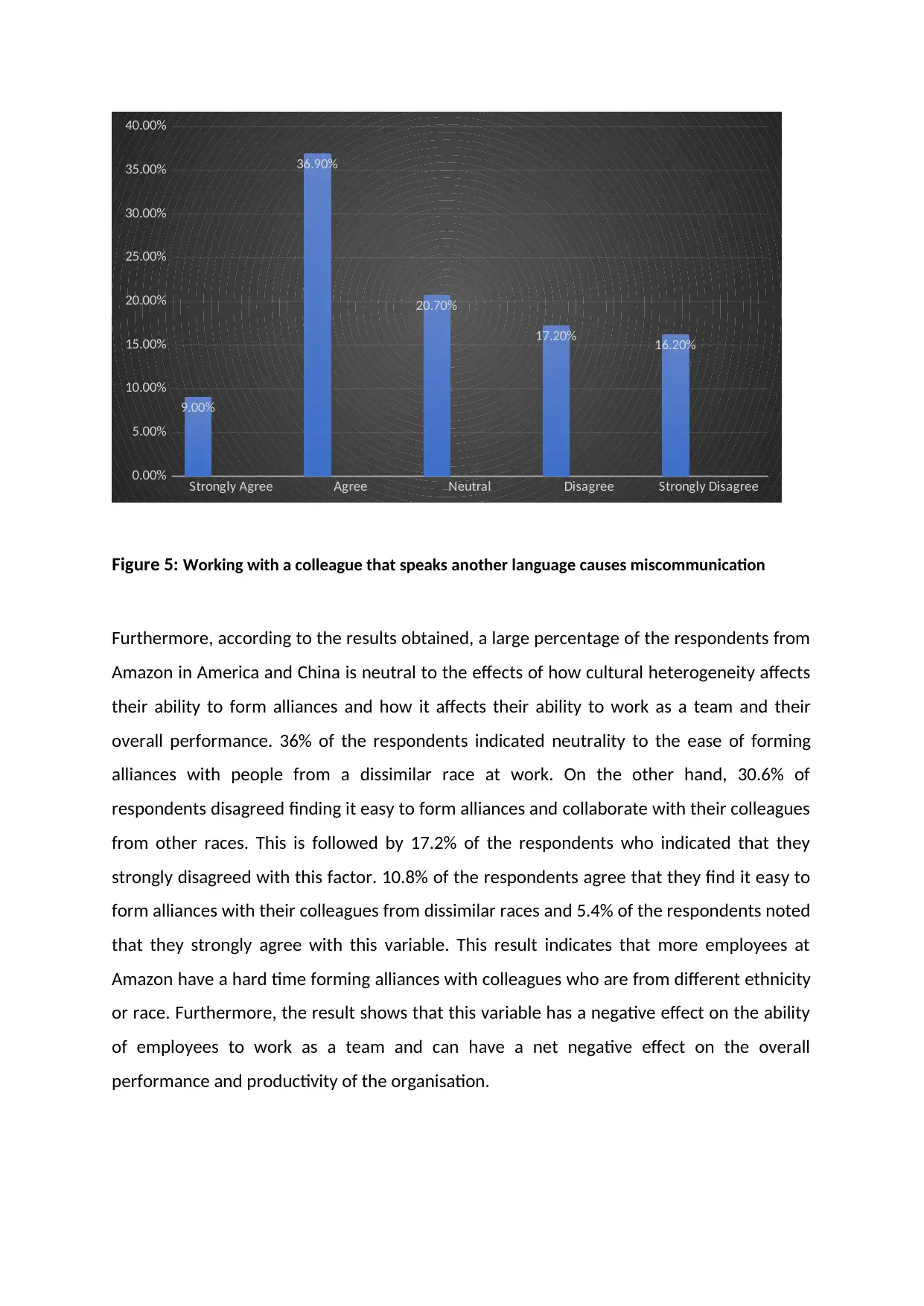
Strongly Agree Agree Neutral Disagree Strongly Disagree
0.00%
5.00%
10.00%
15.00%
20.00%
25.00%
30.00%
35.00%
40.00%
9.00%
36.90%
20.70%
17.20% 16.20%
Figure 5: Working with a colleague that speaks another language causes miscommunication
Furthermore, according to the results obtained, a large percentage of the respondents from
Amazon in America and China is neutral to the effects of how cultural heterogeneity affects
their ability to form alliances and how it affects their ability to work as a team and their
overall performance. 36% of the respondents indicated neutrality to the ease of forming
alliances with people from a dissimilar race at work. On the other hand, 30.6% of
respondents disagreed finding it easy to form alliances and collaborate with their colleagues
from other races. This is followed by 17.2% of the respondents who indicated that they
strongly disagreed with this factor. 10.8% of the respondents agree that they find it easy to
form alliances with their colleagues from dissimilar races and 5.4% of the respondents noted
that they strongly agree with this variable. This result indicates that more employees at
Amazon have a hard time forming alliances with colleagues who are from different ethnicity
or race. Furthermore, the result shows that this variable has a negative effect on the ability
of employees to work as a team and can have a net negative effect on the overall
performance and productivity of the organisation.
0.00%
5.00%
10.00%
15.00%
20.00%
25.00%
30.00%
35.00%
40.00%
9.00%
36.90%
20.70%
17.20% 16.20%
Figure 5: Working with a colleague that speaks another language causes miscommunication
Furthermore, according to the results obtained, a large percentage of the respondents from
Amazon in America and China is neutral to the effects of how cultural heterogeneity affects
their ability to form alliances and how it affects their ability to work as a team and their
overall performance. 36% of the respondents indicated neutrality to the ease of forming
alliances with people from a dissimilar race at work. On the other hand, 30.6% of
respondents disagreed finding it easy to form alliances and collaborate with their colleagues
from other races. This is followed by 17.2% of the respondents who indicated that they
strongly disagreed with this factor. 10.8% of the respondents agree that they find it easy to
form alliances with their colleagues from dissimilar races and 5.4% of the respondents noted
that they strongly agree with this variable. This result indicates that more employees at
Amazon have a hard time forming alliances with colleagues who are from different ethnicity
or race. Furthermore, the result shows that this variable has a negative effect on the ability
of employees to work as a team and can have a net negative effect on the overall
performance and productivity of the organisation.
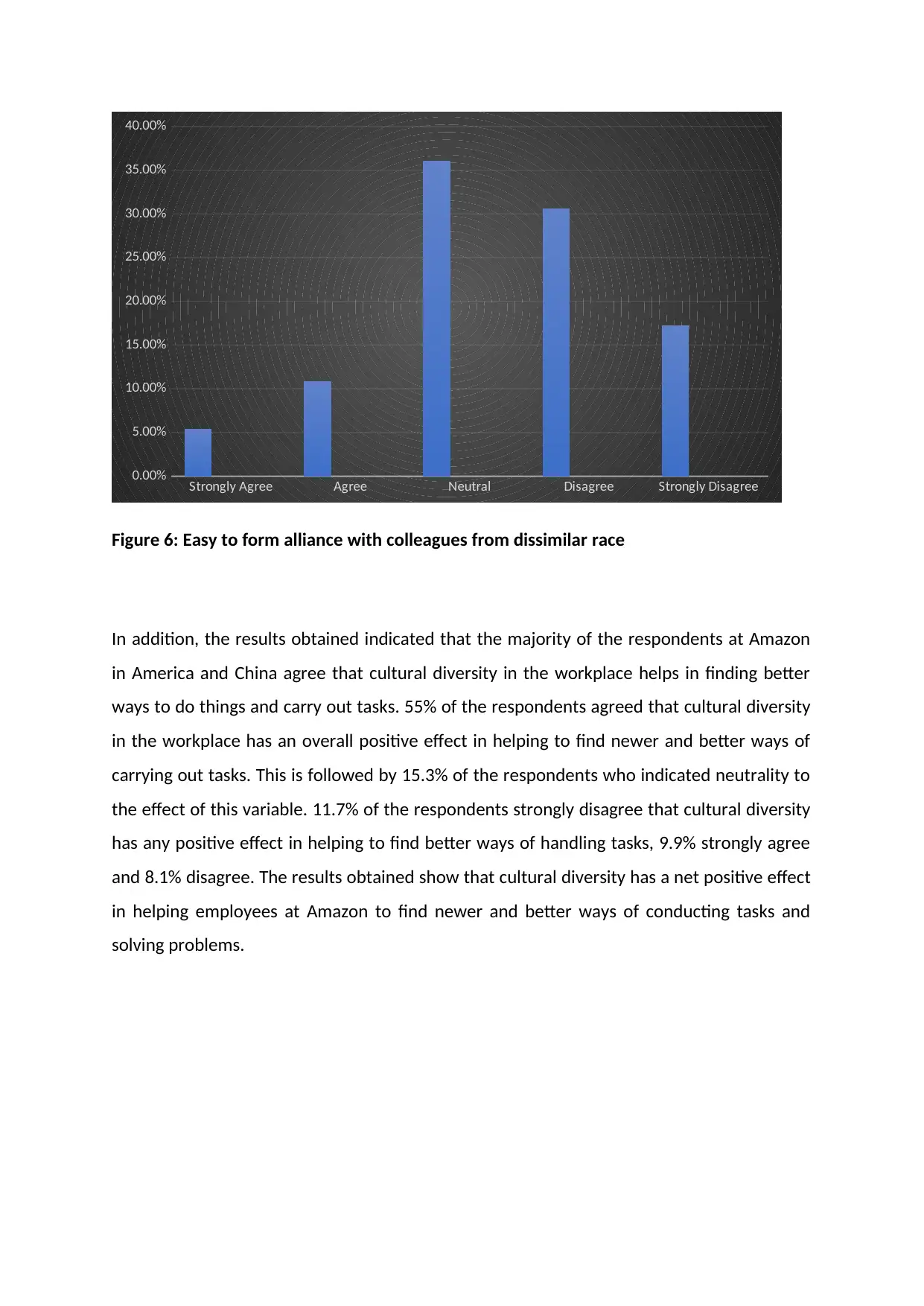
Strongly Agree Agree Neutral Disagree Strongly Disagree
0.00%
5.00%
10.00%
15.00%
20.00%
25.00%
30.00%
35.00%
40.00%
Figure 6: Easy to form alliance with colleagues from dissimilar race
In addition, the results obtained indicated that the majority of the respondents at Amazon
in America and China agree that cultural diversity in the workplace helps in finding better
ways to do things and carry out tasks. 55% of the respondents agreed that cultural diversity
in the workplace has an overall positive effect in helping to find newer and better ways of
carrying out tasks. This is followed by 15.3% of the respondents who indicated neutrality to
the effect of this variable. 11.7% of the respondents strongly disagree that cultural diversity
has any positive effect in helping to find better ways of handling tasks, 9.9% strongly agree
and 8.1% disagree. The results obtained show that cultural diversity has a net positive effect
in helping employees at Amazon to find newer and better ways of conducting tasks and
solving problems.
0.00%
5.00%
10.00%
15.00%
20.00%
25.00%
30.00%
35.00%
40.00%
Figure 6: Easy to form alliance with colleagues from dissimilar race
In addition, the results obtained indicated that the majority of the respondents at Amazon
in America and China agree that cultural diversity in the workplace helps in finding better
ways to do things and carry out tasks. 55% of the respondents agreed that cultural diversity
in the workplace has an overall positive effect in helping to find newer and better ways of
carrying out tasks. This is followed by 15.3% of the respondents who indicated neutrality to
the effect of this variable. 11.7% of the respondents strongly disagree that cultural diversity
has any positive effect in helping to find better ways of handling tasks, 9.9% strongly agree
and 8.1% disagree. The results obtained show that cultural diversity has a net positive effect
in helping employees at Amazon to find newer and better ways of conducting tasks and
solving problems.
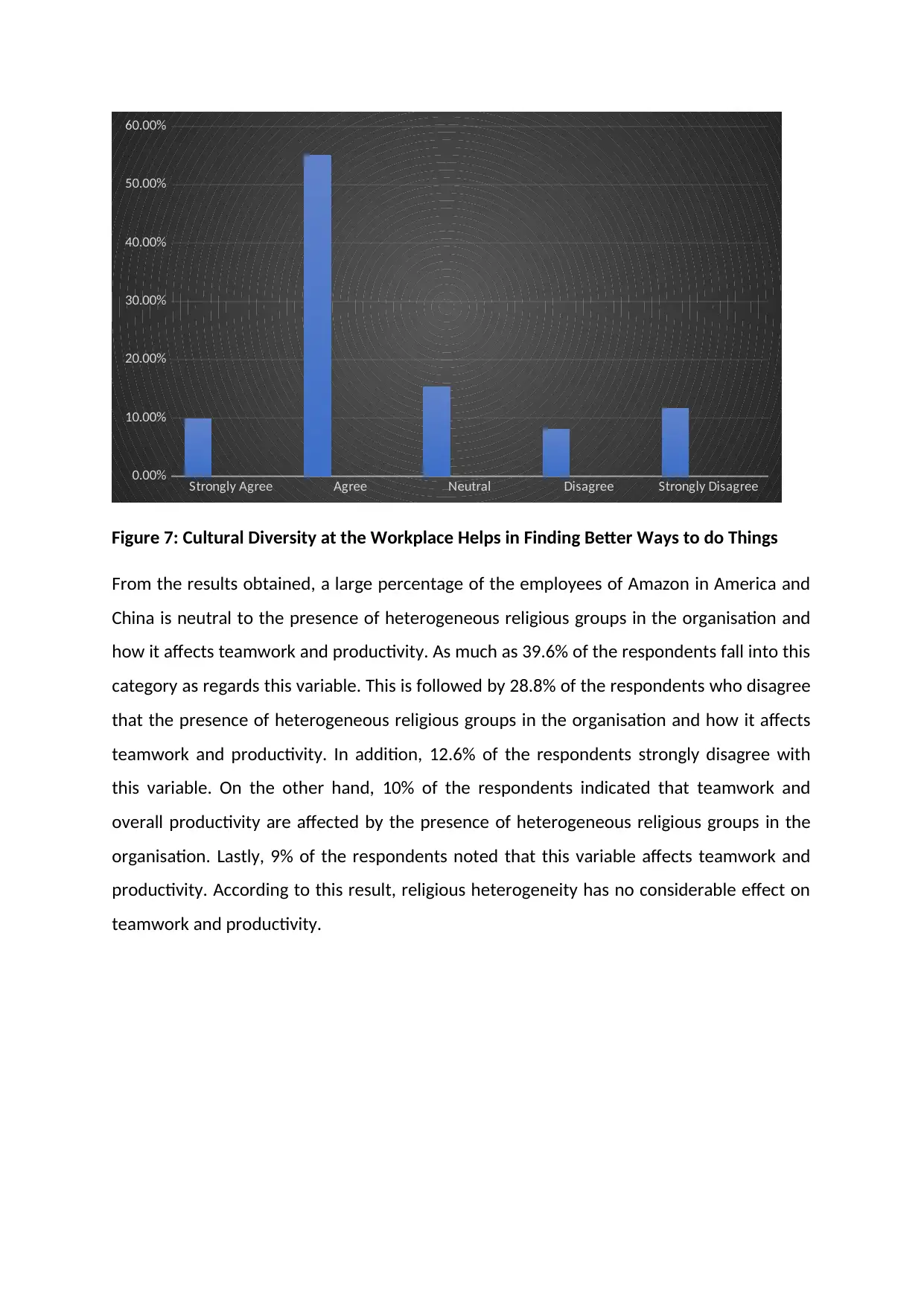
Strongly Agree Agree Neutral Disagree Strongly Disagree
0.00%
10.00%
20.00%
30.00%
40.00%
50.00%
60.00%
Figure 7: Cultural Diversity at the Workplace Helps in Finding Better Ways to do Things
From the results obtained, a large percentage of the employees of Amazon in America and
China is neutral to the presence of heterogeneous religious groups in the organisation and
how it affects teamwork and productivity. As much as 39.6% of the respondents fall into this
category as regards this variable. This is followed by 28.8% of the respondents who disagree
that the presence of heterogeneous religious groups in the organisation and how it affects
teamwork and productivity. In addition, 12.6% of the respondents strongly disagree with
this variable. On the other hand, 10% of the respondents indicated that teamwork and
overall productivity are affected by the presence of heterogeneous religious groups in the
organisation. Lastly, 9% of the respondents noted that this variable affects teamwork and
productivity. According to this result, religious heterogeneity has no considerable effect on
teamwork and productivity.
0.00%
10.00%
20.00%
30.00%
40.00%
50.00%
60.00%
Figure 7: Cultural Diversity at the Workplace Helps in Finding Better Ways to do Things
From the results obtained, a large percentage of the employees of Amazon in America and
China is neutral to the presence of heterogeneous religious groups in the organisation and
how it affects teamwork and productivity. As much as 39.6% of the respondents fall into this
category as regards this variable. This is followed by 28.8% of the respondents who disagree
that the presence of heterogeneous religious groups in the organisation and how it affects
teamwork and productivity. In addition, 12.6% of the respondents strongly disagree with
this variable. On the other hand, 10% of the respondents indicated that teamwork and
overall productivity are affected by the presence of heterogeneous religious groups in the
organisation. Lastly, 9% of the respondents noted that this variable affects teamwork and
productivity. According to this result, religious heterogeneity has no considerable effect on
teamwork and productivity.
Secure Best Marks with AI Grader
Need help grading? Try our AI Grader for instant feedback on your assignments.
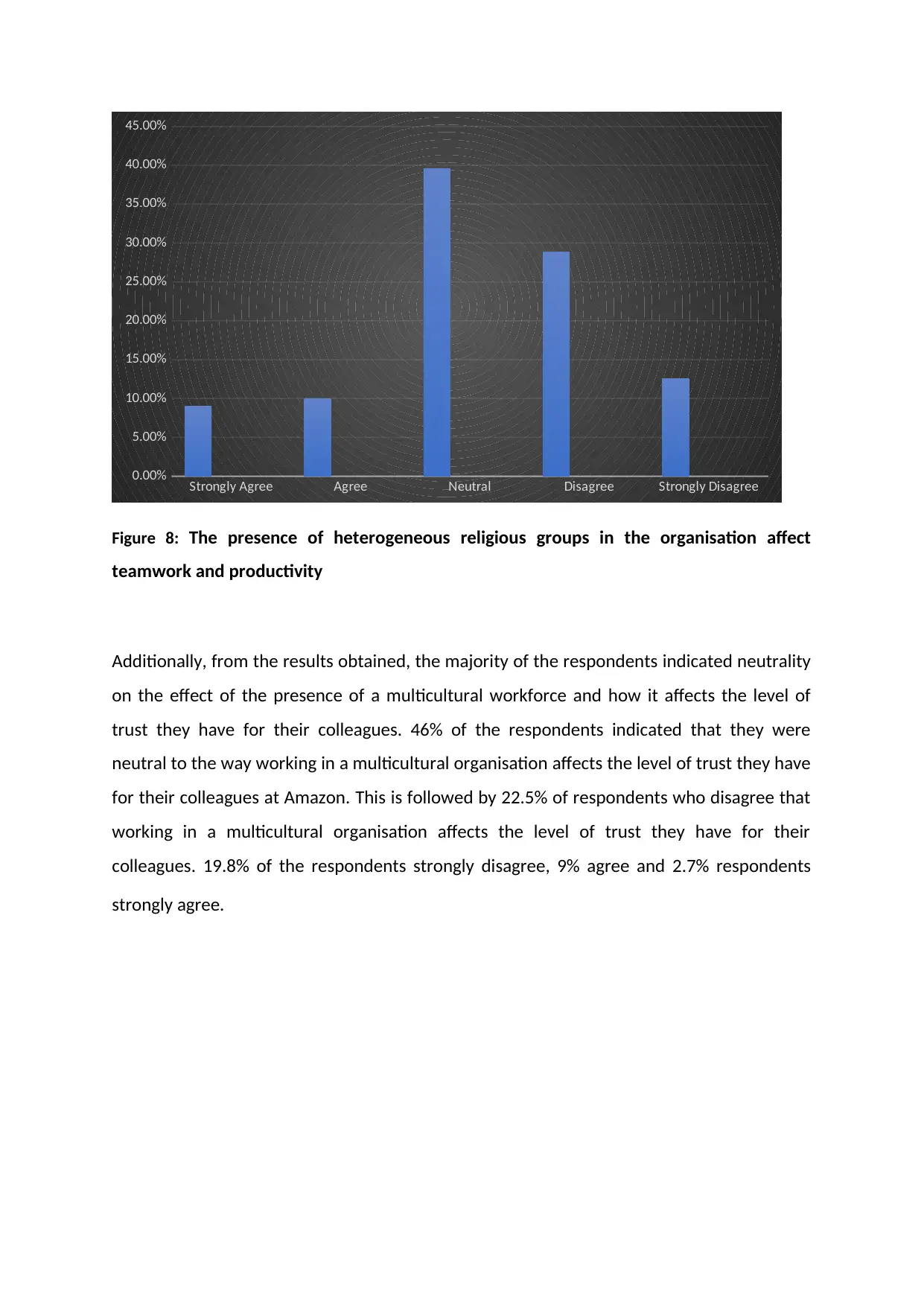
Strongly Agree Agree Neutral Disagree Strongly Disagree
0.00%
5.00%
10.00%
15.00%
20.00%
25.00%
30.00%
35.00%
40.00%
45.00%
Figure 8: The presence of heterogeneous religious groups in the organisation affect
teamwork and productivity
Additionally, from the results obtained, the majority of the respondents indicated neutrality
on the effect of the presence of a multicultural workforce and how it affects the level of
trust they have for their colleagues. 46% of the respondents indicated that they were
neutral to the way working in a multicultural organisation affects the level of trust they have
for their colleagues at Amazon. This is followed by 22.5% of respondents who disagree that
working in a multicultural organisation affects the level of trust they have for their
colleagues. 19.8% of the respondents strongly disagree, 9% agree and 2.7% respondents
strongly agree.
0.00%
5.00%
10.00%
15.00%
20.00%
25.00%
30.00%
35.00%
40.00%
45.00%
Figure 8: The presence of heterogeneous religious groups in the organisation affect
teamwork and productivity
Additionally, from the results obtained, the majority of the respondents indicated neutrality
on the effect of the presence of a multicultural workforce and how it affects the level of
trust they have for their colleagues. 46% of the respondents indicated that they were
neutral to the way working in a multicultural organisation affects the level of trust they have
for their colleagues at Amazon. This is followed by 22.5% of respondents who disagree that
working in a multicultural organisation affects the level of trust they have for their
colleagues. 19.8% of the respondents strongly disagree, 9% agree and 2.7% respondents
strongly agree.

Strongly Agree Agree Neutral Disagree Strongly Disagree
0.00%
5.00%
10.00%
15.00%
20.00%
25.00%
30.00%
35.00%
40.00%
45.00%
50.00%
Figure 9: The presence of a multicultural workforce affects the level of trust you have for
your colleagues
From the results obtained, the majority of the respondents indicated that they disagree that
the ideas of people from different cultural groups are easily accepted at work. A total of
47.7% of the respondents disagree that the opinions or ideas of individuals from different
cultural groups are easily accepted at Amazon. This is followed by 18% of the respondents
who indicated that they agree that the opinions or ideas of people from different cultural
groups are easily accepted at Amazon. 16% of the respondents indicated neutrality to the
effect of this variable, 14.4% strongly disagree and 3.6% strongly agree.
0.00%
5.00%
10.00%
15.00%
20.00%
25.00%
30.00%
35.00%
40.00%
45.00%
50.00%
Figure 9: The presence of a multicultural workforce affects the level of trust you have for
your colleagues
From the results obtained, the majority of the respondents indicated that they disagree that
the ideas of people from different cultural groups are easily accepted at work. A total of
47.7% of the respondents disagree that the opinions or ideas of individuals from different
cultural groups are easily accepted at Amazon. This is followed by 18% of the respondents
who indicated that they agree that the opinions or ideas of people from different cultural
groups are easily accepted at Amazon. 16% of the respondents indicated neutrality to the
effect of this variable, 14.4% strongly disagree and 3.6% strongly agree.
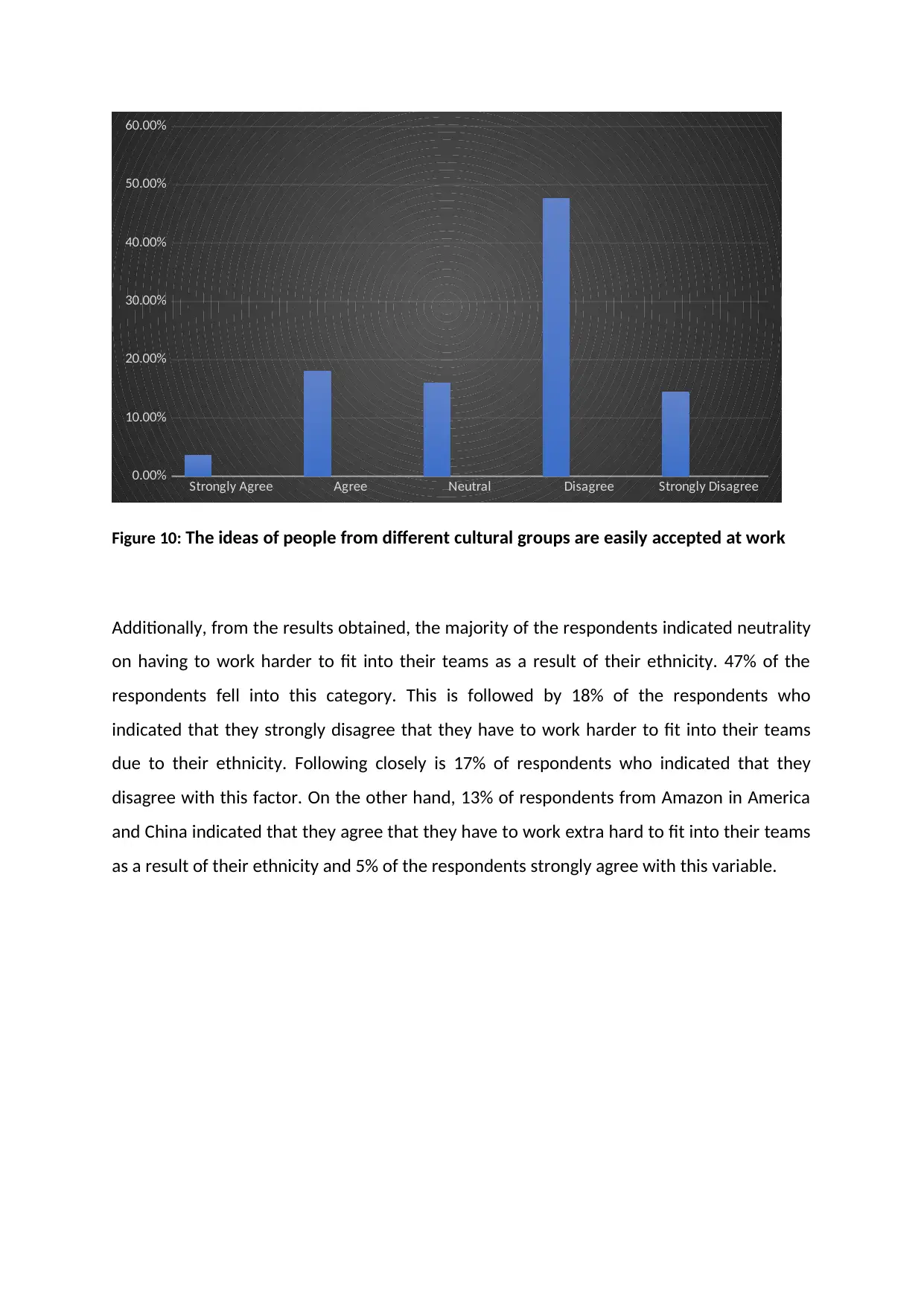
Strongly Agree Agree Neutral Disagree Strongly Disagree
0.00%
10.00%
20.00%
30.00%
40.00%
50.00%
60.00%
Figure 10: The ideas of people from different cultural groups are easily accepted at work
Additionally, from the results obtained, the majority of the respondents indicated neutrality
on having to work harder to fit into their teams as a result of their ethnicity. 47% of the
respondents fell into this category. This is followed by 18% of the respondents who
indicated that they strongly disagree that they have to work harder to fit into their teams
due to their ethnicity. Following closely is 17% of respondents who indicated that they
disagree with this factor. On the other hand, 13% of respondents from Amazon in America
and China indicated that they agree that they have to work extra hard to fit into their teams
as a result of their ethnicity and 5% of the respondents strongly agree with this variable.
0.00%
10.00%
20.00%
30.00%
40.00%
50.00%
60.00%
Figure 10: The ideas of people from different cultural groups are easily accepted at work
Additionally, from the results obtained, the majority of the respondents indicated neutrality
on having to work harder to fit into their teams as a result of their ethnicity. 47% of the
respondents fell into this category. This is followed by 18% of the respondents who
indicated that they strongly disagree that they have to work harder to fit into their teams
due to their ethnicity. Following closely is 17% of respondents who indicated that they
disagree with this factor. On the other hand, 13% of respondents from Amazon in America
and China indicated that they agree that they have to work extra hard to fit into their teams
as a result of their ethnicity and 5% of the respondents strongly agree with this variable.
Paraphrase This Document
Need a fresh take? Get an instant paraphrase of this document with our AI Paraphraser

Strongly Agree Agree Neutral Disagree Strongly Disagree
0.00%
5.00%
10.00%
15.00%
20.00%
25.00%
30.00%
35.00%
40.00%
45.00%
50.00%
Figure 11: You have to work harder to fit into your team as a result of your ethnicity
Discussion of Findings
This study was undertaken to determine the effect of a multicultural workforce on the
teamwork and organisational performance of Amazon employees in America and China. It
has been noted that in organisations, teams are of great importance. According to Shaikh et
al (2019), teamwork provides varying benefits not only for the organisation but for its
employees as well. Effective teamwork facilitates the ease of accomplishing tasks more
rapidly and efficiently. Therefore, for any organisation to achieve success, it is necessary
that they have effective teamwork in place (ibid.). In the research, various factors were
taken into consideration that can affect teamwork and organisational performance in
multicultural organisations like Amazon. The factors include: how working with colleagues
from different ethnicities affects work performance negatively, how working with a
colleague that speaks another language causes miscommunication, how easy it is to form
alliances with people from a dissimilar race at work, and how cultural diversity at the
workplace helps in finding better ways to do things, how the presence of heterogeneous
religious groups in the organisation affect teamwork and productivity, how the presence of
a multicultural workforce affects the level of trust you have for colleagues, how easy it is to
0.00%
5.00%
10.00%
15.00%
20.00%
25.00%
30.00%
35.00%
40.00%
45.00%
50.00%
Figure 11: You have to work harder to fit into your team as a result of your ethnicity
Discussion of Findings
This study was undertaken to determine the effect of a multicultural workforce on the
teamwork and organisational performance of Amazon employees in America and China. It
has been noted that in organisations, teams are of great importance. According to Shaikh et
al (2019), teamwork provides varying benefits not only for the organisation but for its
employees as well. Effective teamwork facilitates the ease of accomplishing tasks more
rapidly and efficiently. Therefore, for any organisation to achieve success, it is necessary
that they have effective teamwork in place (ibid.). In the research, various factors were
taken into consideration that can affect teamwork and organisational performance in
multicultural organisations like Amazon. The factors include: how working with colleagues
from different ethnicities affects work performance negatively, how working with a
colleague that speaks another language causes miscommunication, how easy it is to form
alliances with people from a dissimilar race at work, and how cultural diversity at the
workplace helps in finding better ways to do things, how the presence of heterogeneous
religious groups in the organisation affect teamwork and productivity, how the presence of
a multicultural workforce affects the level of trust you have for colleagues, how easy it is to
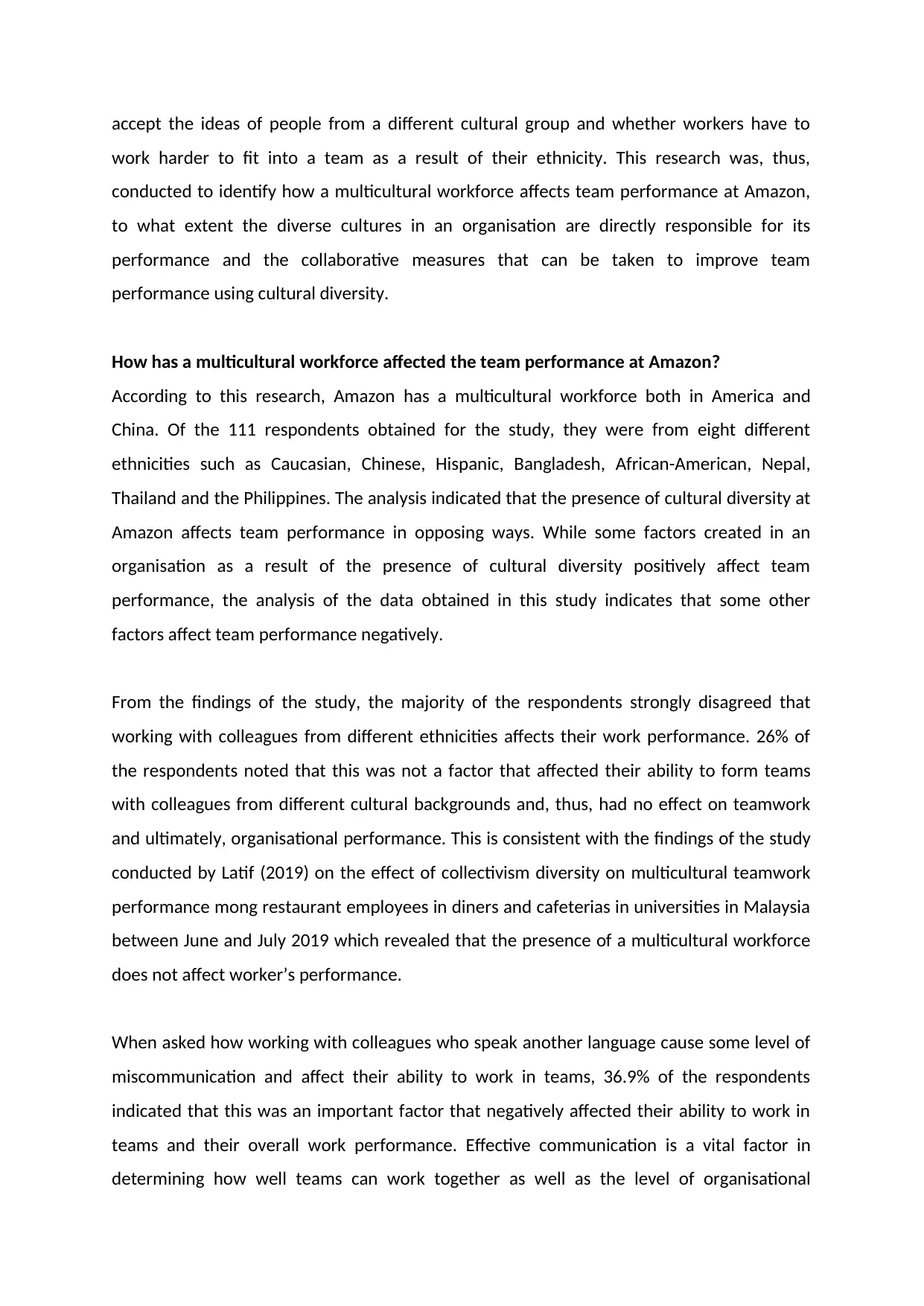
accept the ideas of people from a different cultural group and whether workers have to
work harder to fit into a team as a result of their ethnicity. This research was, thus,
conducted to identify how a multicultural workforce affects team performance at Amazon,
to what extent the diverse cultures in an organisation are directly responsible for its
performance and the collaborative measures that can be taken to improve team
performance using cultural diversity.
How has a multicultural workforce affected the team performance at Amazon?
According to this research, Amazon has a multicultural workforce both in America and
China. Of the 111 respondents obtained for the study, they were from eight different
ethnicities such as Caucasian, Chinese, Hispanic, Bangladesh, African-American, Nepal,
Thailand and the Philippines. The analysis indicated that the presence of cultural diversity at
Amazon affects team performance in opposing ways. While some factors created in an
organisation as a result of the presence of cultural diversity positively affect team
performance, the analysis of the data obtained in this study indicates that some other
factors affect team performance negatively.
From the findings of the study, the majority of the respondents strongly disagreed that
working with colleagues from different ethnicities affects their work performance. 26% of
the respondents noted that this was not a factor that affected their ability to form teams
with colleagues from different cultural backgrounds and, thus, had no effect on teamwork
and ultimately, organisational performance. This is consistent with the findings of the study
conducted by Latif (2019) on the effect of collectivism diversity on multicultural teamwork
performance mong restaurant employees in diners and cafeterias in universities in Malaysia
between June and July 2019 which revealed that the presence of a multicultural workforce
does not affect worker’s performance.
When asked how working with colleagues who speak another language cause some level of
miscommunication and affect their ability to work in teams, 36.9% of the respondents
indicated that this was an important factor that negatively affected their ability to work in
teams and their overall work performance. Effective communication is a vital factor in
determining how well teams can work together as well as the level of organisational
work harder to fit into a team as a result of their ethnicity. This research was, thus,
conducted to identify how a multicultural workforce affects team performance at Amazon,
to what extent the diverse cultures in an organisation are directly responsible for its
performance and the collaborative measures that can be taken to improve team
performance using cultural diversity.
How has a multicultural workforce affected the team performance at Amazon?
According to this research, Amazon has a multicultural workforce both in America and
China. Of the 111 respondents obtained for the study, they were from eight different
ethnicities such as Caucasian, Chinese, Hispanic, Bangladesh, African-American, Nepal,
Thailand and the Philippines. The analysis indicated that the presence of cultural diversity at
Amazon affects team performance in opposing ways. While some factors created in an
organisation as a result of the presence of cultural diversity positively affect team
performance, the analysis of the data obtained in this study indicates that some other
factors affect team performance negatively.
From the findings of the study, the majority of the respondents strongly disagreed that
working with colleagues from different ethnicities affects their work performance. 26% of
the respondents noted that this was not a factor that affected their ability to form teams
with colleagues from different cultural backgrounds and, thus, had no effect on teamwork
and ultimately, organisational performance. This is consistent with the findings of the study
conducted by Latif (2019) on the effect of collectivism diversity on multicultural teamwork
performance mong restaurant employees in diners and cafeterias in universities in Malaysia
between June and July 2019 which revealed that the presence of a multicultural workforce
does not affect worker’s performance.
When asked how working with colleagues who speak another language cause some level of
miscommunication and affect their ability to work in teams, 36.9% of the respondents
indicated that this was an important factor that negatively affected their ability to work in
teams and their overall work performance. Effective communication is a vital factor in
determining how well teams can work together as well as the level of organisational
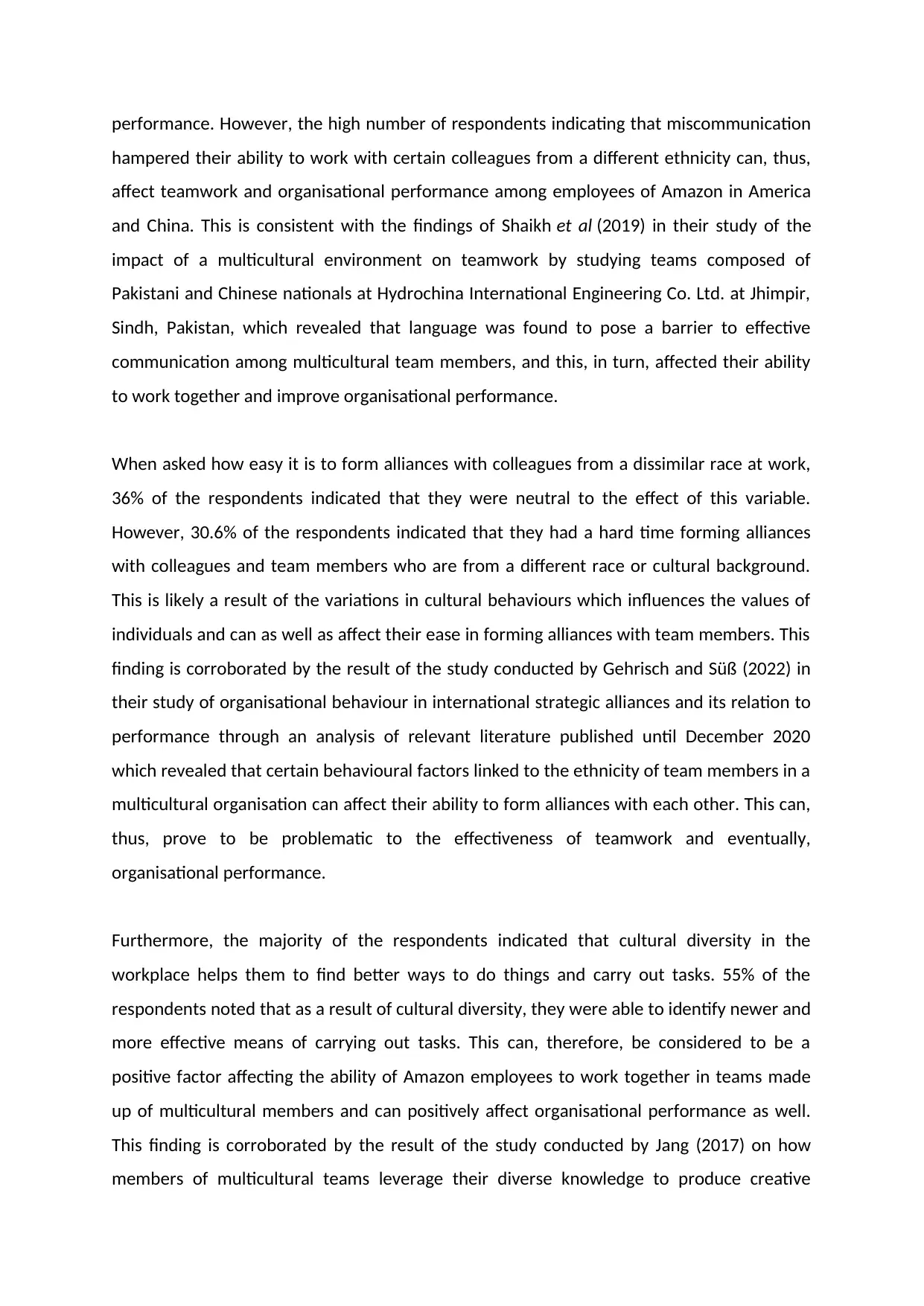
performance. However, the high number of respondents indicating that miscommunication
hampered their ability to work with certain colleagues from a different ethnicity can, thus,
affect teamwork and organisational performance among employees of Amazon in America
and China. This is consistent with the findings of Shaikh et al (2019) in their study of the
impact of a multicultural environment on teamwork by studying teams composed of
Pakistani and Chinese nationals at Hydrochina International Engineering Co. Ltd. at Jhimpir,
Sindh, Pakistan, which revealed that language was found to pose a barrier to effective
communication among multicultural team members, and this, in turn, affected their ability
to work together and improve organisational performance.
When asked how easy it is to form alliances with colleagues from a dissimilar race at work,
36% of the respondents indicated that they were neutral to the effect of this variable.
However, 30.6% of the respondents indicated that they had a hard time forming alliances
with colleagues and team members who are from a different race or cultural background.
This is likely a result of the variations in cultural behaviours which influences the values of
individuals and can as well as affect their ease in forming alliances with team members. This
finding is corroborated by the result of the study conducted by Gehrisch and Süß (2022) in
their study of organisational behaviour in international strategic alliances and its relation to
performance through an analysis of relevant literature published until December 2020
which revealed that certain behavioural factors linked to the ethnicity of team members in a
multicultural organisation can affect their ability to form alliances with each other. This can,
thus, prove to be problematic to the effectiveness of teamwork and eventually,
organisational performance.
Furthermore, the majority of the respondents indicated that cultural diversity in the
workplace helps them to find better ways to do things and carry out tasks. 55% of the
respondents noted that as a result of cultural diversity, they were able to identify newer and
more effective means of carrying out tasks. This can, therefore, be considered to be a
positive factor affecting the ability of Amazon employees to work together in teams made
up of multicultural members and can positively affect organisational performance as well.
This finding is corroborated by the result of the study conducted by Jang (2017) on how
members of multicultural teams leverage their diverse knowledge to produce creative
hampered their ability to work with certain colleagues from a different ethnicity can, thus,
affect teamwork and organisational performance among employees of Amazon in America
and China. This is consistent with the findings of Shaikh et al (2019) in their study of the
impact of a multicultural environment on teamwork by studying teams composed of
Pakistani and Chinese nationals at Hydrochina International Engineering Co. Ltd. at Jhimpir,
Sindh, Pakistan, which revealed that language was found to pose a barrier to effective
communication among multicultural team members, and this, in turn, affected their ability
to work together and improve organisational performance.
When asked how easy it is to form alliances with colleagues from a dissimilar race at work,
36% of the respondents indicated that they were neutral to the effect of this variable.
However, 30.6% of the respondents indicated that they had a hard time forming alliances
with colleagues and team members who are from a different race or cultural background.
This is likely a result of the variations in cultural behaviours which influences the values of
individuals and can as well as affect their ease in forming alliances with team members. This
finding is corroborated by the result of the study conducted by Gehrisch and Süß (2022) in
their study of organisational behaviour in international strategic alliances and its relation to
performance through an analysis of relevant literature published until December 2020
which revealed that certain behavioural factors linked to the ethnicity of team members in a
multicultural organisation can affect their ability to form alliances with each other. This can,
thus, prove to be problematic to the effectiveness of teamwork and eventually,
organisational performance.
Furthermore, the majority of the respondents indicated that cultural diversity in the
workplace helps them to find better ways to do things and carry out tasks. 55% of the
respondents noted that as a result of cultural diversity, they were able to identify newer and
more effective means of carrying out tasks. This can, therefore, be considered to be a
positive factor affecting the ability of Amazon employees to work together in teams made
up of multicultural members and can positively affect organisational performance as well.
This finding is corroborated by the result of the study conducted by Jang (2017) on how
members of multicultural teams leverage their diverse knowledge to produce creative
Secure Best Marks with AI Grader
Need help grading? Try our AI Grader for instant feedback on your assignments.
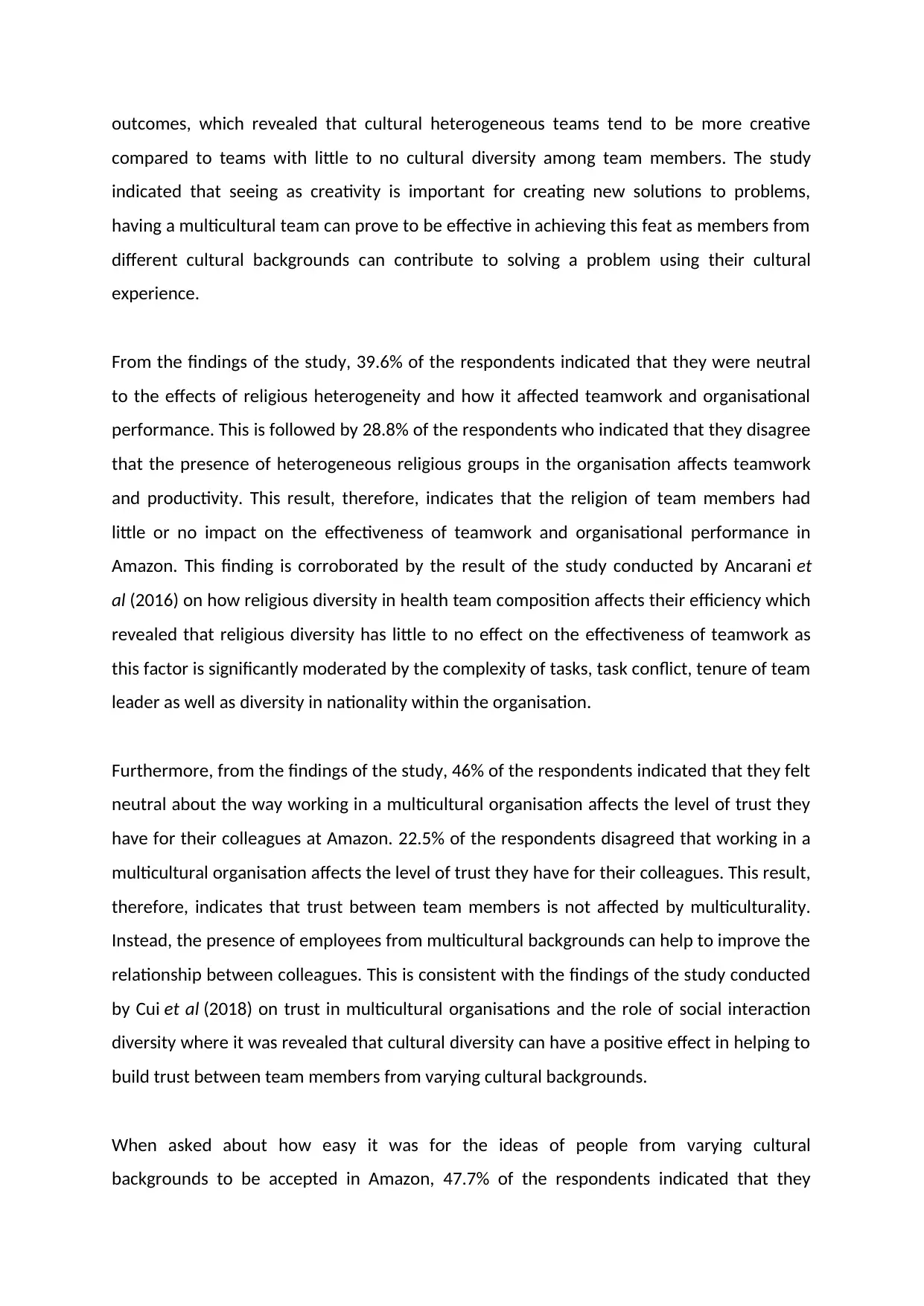
outcomes, which revealed that cultural heterogeneous teams tend to be more creative
compared to teams with little to no cultural diversity among team members. The study
indicated that seeing as creativity is important for creating new solutions to problems,
having a multicultural team can prove to be effective in achieving this feat as members from
different cultural backgrounds can contribute to solving a problem using their cultural
experience.
From the findings of the study, 39.6% of the respondents indicated that they were neutral
to the effects of religious heterogeneity and how it affected teamwork and organisational
performance. This is followed by 28.8% of the respondents who indicated that they disagree
that the presence of heterogeneous religious groups in the organisation affects teamwork
and productivity. This result, therefore, indicates that the religion of team members had
little or no impact on the effectiveness of teamwork and organisational performance in
Amazon. This finding is corroborated by the result of the study conducted by Ancarani et
al (2016) on how religious diversity in health team composition affects their efficiency which
revealed that religious diversity has little to no effect on the effectiveness of teamwork as
this factor is significantly moderated by the complexity of tasks, task conflict, tenure of team
leader as well as diversity in nationality within the organisation.
Furthermore, from the findings of the study, 46% of the respondents indicated that they felt
neutral about the way working in a multicultural organisation affects the level of trust they
have for their colleagues at Amazon. 22.5% of the respondents disagreed that working in a
multicultural organisation affects the level of trust they have for their colleagues. This result,
therefore, indicates that trust between team members is not affected by multiculturality.
Instead, the presence of employees from multicultural backgrounds can help to improve the
relationship between colleagues. This is consistent with the findings of the study conducted
by Cui et al (2018) on trust in multicultural organisations and the role of social interaction
diversity where it was revealed that cultural diversity can have a positive effect in helping to
build trust between team members from varying cultural backgrounds.
When asked about how easy it was for the ideas of people from varying cultural
backgrounds to be accepted in Amazon, 47.7% of the respondents indicated that they
compared to teams with little to no cultural diversity among team members. The study
indicated that seeing as creativity is important for creating new solutions to problems,
having a multicultural team can prove to be effective in achieving this feat as members from
different cultural backgrounds can contribute to solving a problem using their cultural
experience.
From the findings of the study, 39.6% of the respondents indicated that they were neutral
to the effects of religious heterogeneity and how it affected teamwork and organisational
performance. This is followed by 28.8% of the respondents who indicated that they disagree
that the presence of heterogeneous religious groups in the organisation affects teamwork
and productivity. This result, therefore, indicates that the religion of team members had
little or no impact on the effectiveness of teamwork and organisational performance in
Amazon. This finding is corroborated by the result of the study conducted by Ancarani et
al (2016) on how religious diversity in health team composition affects their efficiency which
revealed that religious diversity has little to no effect on the effectiveness of teamwork as
this factor is significantly moderated by the complexity of tasks, task conflict, tenure of team
leader as well as diversity in nationality within the organisation.
Furthermore, from the findings of the study, 46% of the respondents indicated that they felt
neutral about the way working in a multicultural organisation affects the level of trust they
have for their colleagues at Amazon. 22.5% of the respondents disagreed that working in a
multicultural organisation affects the level of trust they have for their colleagues. This result,
therefore, indicates that trust between team members is not affected by multiculturality.
Instead, the presence of employees from multicultural backgrounds can help to improve the
relationship between colleagues. This is consistent with the findings of the study conducted
by Cui et al (2018) on trust in multicultural organisations and the role of social interaction
diversity where it was revealed that cultural diversity can have a positive effect in helping to
build trust between team members from varying cultural backgrounds.
When asked about how easy it was for the ideas of people from varying cultural
backgrounds to be accepted in Amazon, 47.7% of the respondents indicated that they
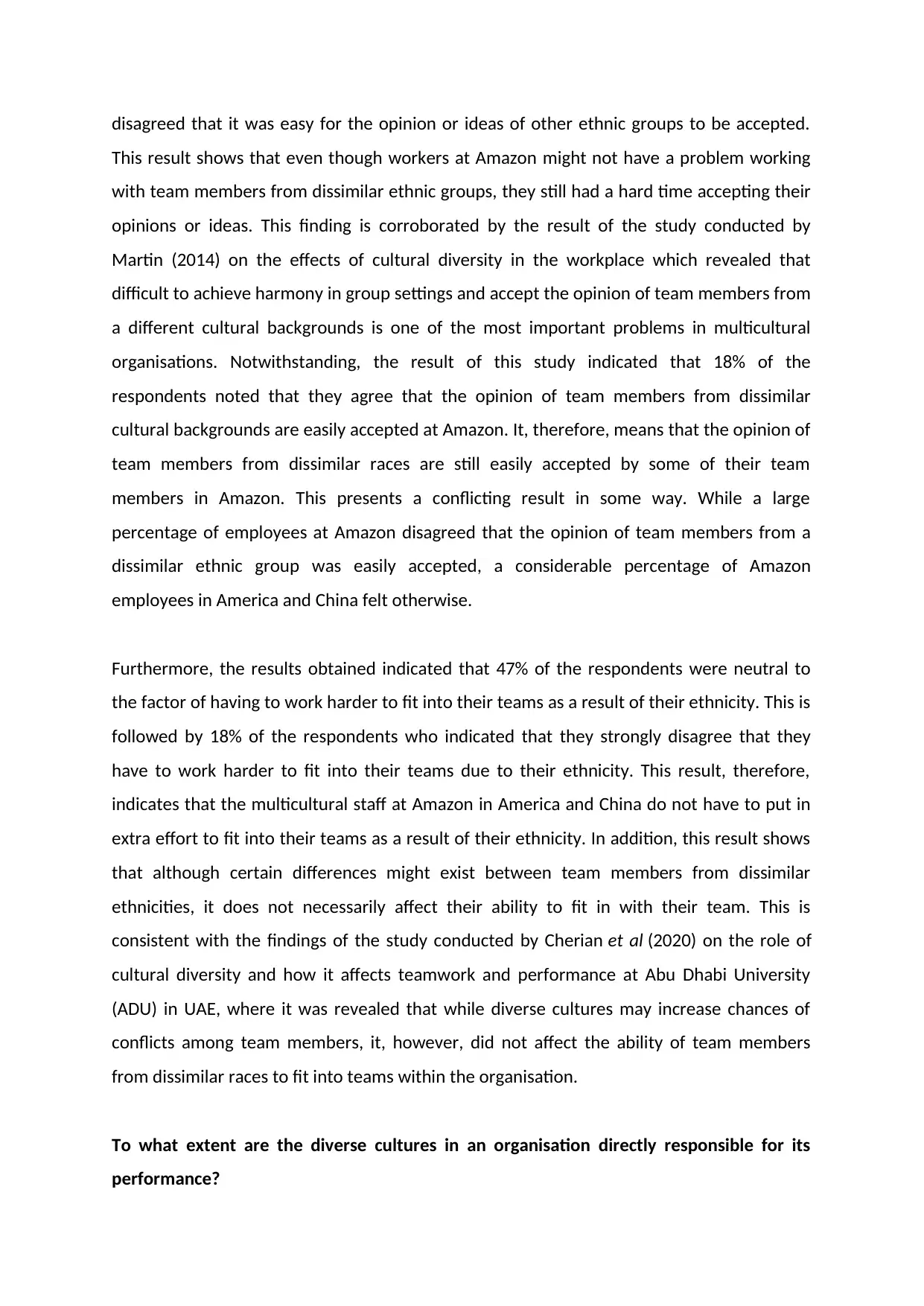
disagreed that it was easy for the opinion or ideas of other ethnic groups to be accepted.
This result shows that even though workers at Amazon might not have a problem working
with team members from dissimilar ethnic groups, they still had a hard time accepting their
opinions or ideas. This finding is corroborated by the result of the study conducted by
Martin (2014) on the effects of cultural diversity in the workplace which revealed that
difficult to achieve harmony in group settings and accept the opinion of team members from
a different cultural backgrounds is one of the most important problems in multicultural
organisations. Notwithstanding, the result of this study indicated that 18% of the
respondents noted that they agree that the opinion of team members from dissimilar
cultural backgrounds are easily accepted at Amazon. It, therefore, means that the opinion of
team members from dissimilar races are still easily accepted by some of their team
members in Amazon. This presents a conflicting result in some way. While a large
percentage of employees at Amazon disagreed that the opinion of team members from a
dissimilar ethnic group was easily accepted, a considerable percentage of Amazon
employees in America and China felt otherwise.
Furthermore, the results obtained indicated that 47% of the respondents were neutral to
the factor of having to work harder to fit into their teams as a result of their ethnicity. This is
followed by 18% of the respondents who indicated that they strongly disagree that they
have to work harder to fit into their teams due to their ethnicity. This result, therefore,
indicates that the multicultural staff at Amazon in America and China do not have to put in
extra effort to fit into their teams as a result of their ethnicity. In addition, this result shows
that although certain differences might exist between team members from dissimilar
ethnicities, it does not necessarily affect their ability to fit in with their team. This is
consistent with the findings of the study conducted by Cherian et al (2020) on the role of
cultural diversity and how it affects teamwork and performance at Abu Dhabi University
(ADU) in UAE, where it was revealed that while diverse cultures may increase chances of
conflicts among team members, it, however, did not affect the ability of team members
from dissimilar races to fit into teams within the organisation.
To what extent are the diverse cultures in an organisation directly responsible for its
performance?
This result shows that even though workers at Amazon might not have a problem working
with team members from dissimilar ethnic groups, they still had a hard time accepting their
opinions or ideas. This finding is corroborated by the result of the study conducted by
Martin (2014) on the effects of cultural diversity in the workplace which revealed that
difficult to achieve harmony in group settings and accept the opinion of team members from
a different cultural backgrounds is one of the most important problems in multicultural
organisations. Notwithstanding, the result of this study indicated that 18% of the
respondents noted that they agree that the opinion of team members from dissimilar
cultural backgrounds are easily accepted at Amazon. It, therefore, means that the opinion of
team members from dissimilar races are still easily accepted by some of their team
members in Amazon. This presents a conflicting result in some way. While a large
percentage of employees at Amazon disagreed that the opinion of team members from a
dissimilar ethnic group was easily accepted, a considerable percentage of Amazon
employees in America and China felt otherwise.
Furthermore, the results obtained indicated that 47% of the respondents were neutral to
the factor of having to work harder to fit into their teams as a result of their ethnicity. This is
followed by 18% of the respondents who indicated that they strongly disagree that they
have to work harder to fit into their teams due to their ethnicity. This result, therefore,
indicates that the multicultural staff at Amazon in America and China do not have to put in
extra effort to fit into their teams as a result of their ethnicity. In addition, this result shows
that although certain differences might exist between team members from dissimilar
ethnicities, it does not necessarily affect their ability to fit in with their team. This is
consistent with the findings of the study conducted by Cherian et al (2020) on the role of
cultural diversity and how it affects teamwork and performance at Abu Dhabi University
(ADU) in UAE, where it was revealed that while diverse cultures may increase chances of
conflicts among team members, it, however, did not affect the ability of team members
from dissimilar races to fit into teams within the organisation.
To what extent are the diverse cultures in an organisation directly responsible for its
performance?
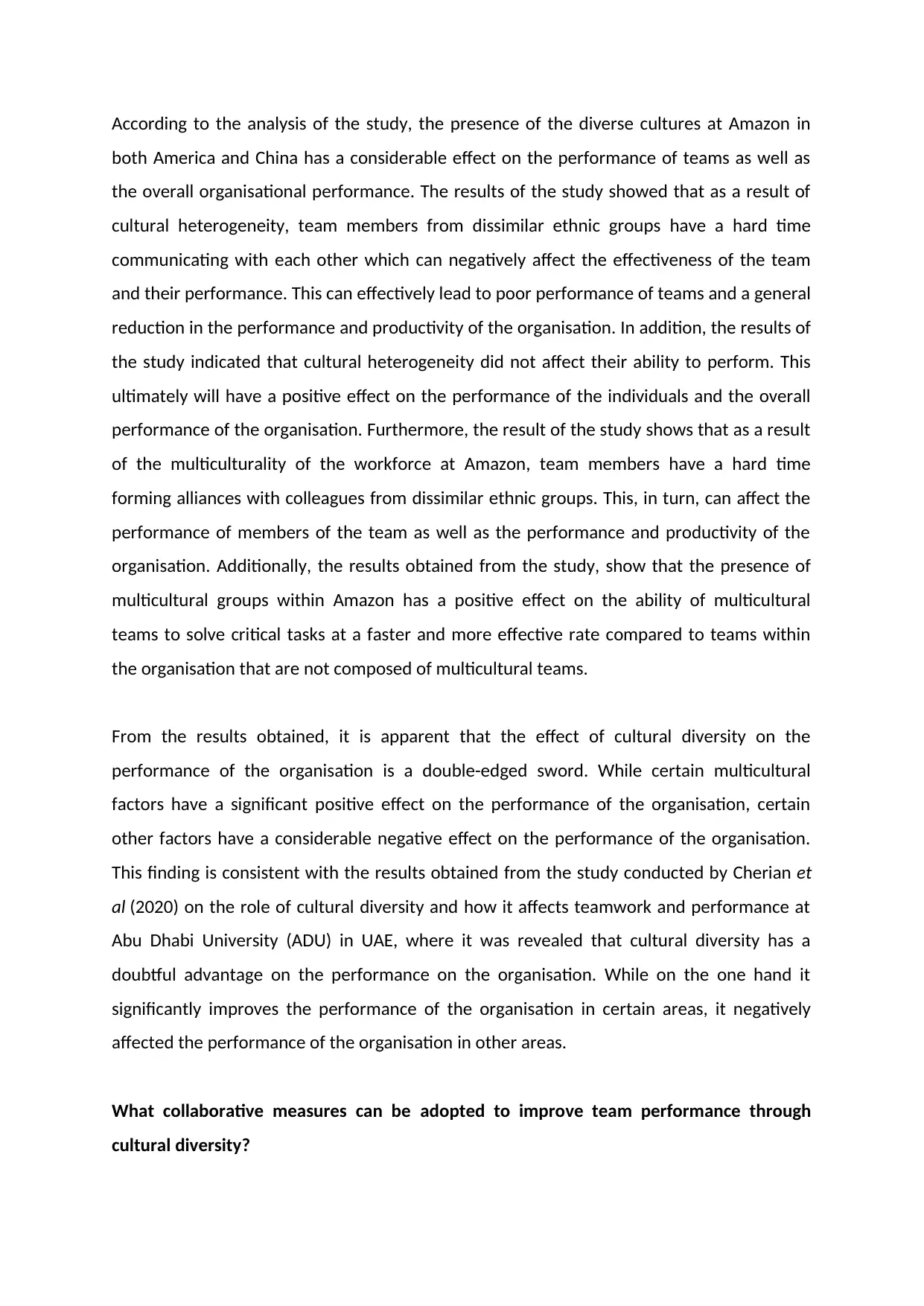
According to the analysis of the study, the presence of the diverse cultures at Amazon in
both America and China has a considerable effect on the performance of teams as well as
the overall organisational performance. The results of the study showed that as a result of
cultural heterogeneity, team members from dissimilar ethnic groups have a hard time
communicating with each other which can negatively affect the effectiveness of the team
and their performance. This can effectively lead to poor performance of teams and a general
reduction in the performance and productivity of the organisation. In addition, the results of
the study indicated that cultural heterogeneity did not affect their ability to perform. This
ultimately will have a positive effect on the performance of the individuals and the overall
performance of the organisation. Furthermore, the result of the study shows that as a result
of the multiculturality of the workforce at Amazon, team members have a hard time
forming alliances with colleagues from dissimilar ethnic groups. This, in turn, can affect the
performance of members of the team as well as the performance and productivity of the
organisation. Additionally, the results obtained from the study, show that the presence of
multicultural groups within Amazon has a positive effect on the ability of multicultural
teams to solve critical tasks at a faster and more effective rate compared to teams within
the organisation that are not composed of multicultural teams.
From the results obtained, it is apparent that the effect of cultural diversity on the
performance of the organisation is a double-edged sword. While certain multicultural
factors have a significant positive effect on the performance of the organisation, certain
other factors have a considerable negative effect on the performance of the organisation.
This finding is consistent with the results obtained from the study conducted by Cherian et
al (2020) on the role of cultural diversity and how it affects teamwork and performance at
Abu Dhabi University (ADU) in UAE, where it was revealed that cultural diversity has a
doubtful advantage on the performance on the organisation. While on the one hand it
significantly improves the performance of the organisation in certain areas, it negatively
affected the performance of the organisation in other areas.
What collaborative measures can be adopted to improve team performance through
cultural diversity?
both America and China has a considerable effect on the performance of teams as well as
the overall organisational performance. The results of the study showed that as a result of
cultural heterogeneity, team members from dissimilar ethnic groups have a hard time
communicating with each other which can negatively affect the effectiveness of the team
and their performance. This can effectively lead to poor performance of teams and a general
reduction in the performance and productivity of the organisation. In addition, the results of
the study indicated that cultural heterogeneity did not affect their ability to perform. This
ultimately will have a positive effect on the performance of the individuals and the overall
performance of the organisation. Furthermore, the result of the study shows that as a result
of the multiculturality of the workforce at Amazon, team members have a hard time
forming alliances with colleagues from dissimilar ethnic groups. This, in turn, can affect the
performance of members of the team as well as the performance and productivity of the
organisation. Additionally, the results obtained from the study, show that the presence of
multicultural groups within Amazon has a positive effect on the ability of multicultural
teams to solve critical tasks at a faster and more effective rate compared to teams within
the organisation that are not composed of multicultural teams.
From the results obtained, it is apparent that the effect of cultural diversity on the
performance of the organisation is a double-edged sword. While certain multicultural
factors have a significant positive effect on the performance of the organisation, certain
other factors have a considerable negative effect on the performance of the organisation.
This finding is consistent with the results obtained from the study conducted by Cherian et
al (2020) on the role of cultural diversity and how it affects teamwork and performance at
Abu Dhabi University (ADU) in UAE, where it was revealed that cultural diversity has a
doubtful advantage on the performance on the organisation. While on the one hand it
significantly improves the performance of the organisation in certain areas, it negatively
affected the performance of the organisation in other areas.
What collaborative measures can be adopted to improve team performance through
cultural diversity?
Paraphrase This Document
Need a fresh take? Get an instant paraphrase of this document with our AI Paraphraser
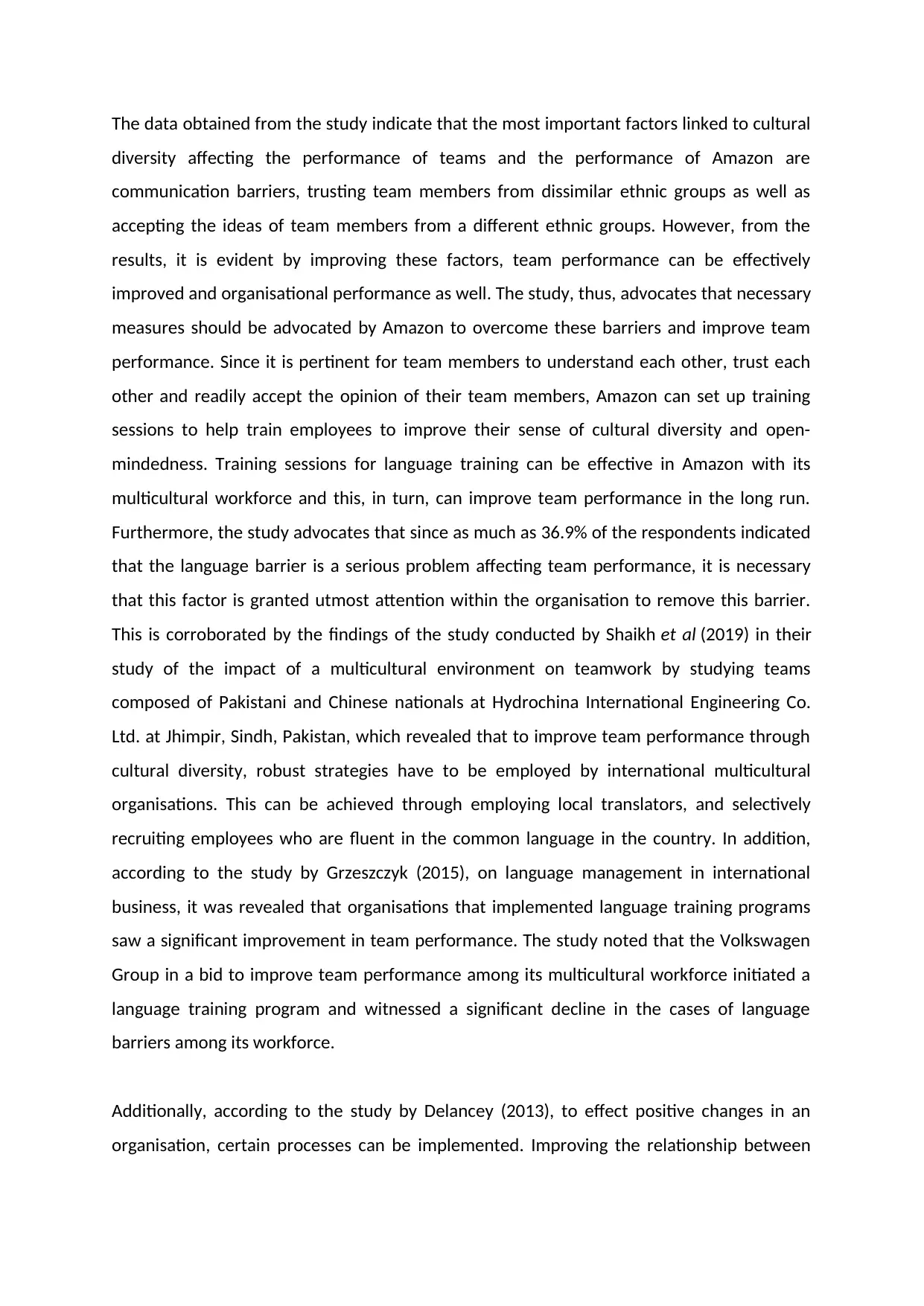
The data obtained from the study indicate that the most important factors linked to cultural
diversity affecting the performance of teams and the performance of Amazon are
communication barriers, trusting team members from dissimilar ethnic groups as well as
accepting the ideas of team members from a different ethnic groups. However, from the
results, it is evident by improving these factors, team performance can be effectively
improved and organisational performance as well. The study, thus, advocates that necessary
measures should be advocated by Amazon to overcome these barriers and improve team
performance. Since it is pertinent for team members to understand each other, trust each
other and readily accept the opinion of their team members, Amazon can set up training
sessions to help train employees to improve their sense of cultural diversity and open-
mindedness. Training sessions for language training can be effective in Amazon with its
multicultural workforce and this, in turn, can improve team performance in the long run.
Furthermore, the study advocates that since as much as 36.9% of the respondents indicated
that the language barrier is a serious problem affecting team performance, it is necessary
that this factor is granted utmost attention within the organisation to remove this barrier.
This is corroborated by the findings of the study conducted by Shaikh et al (2019) in their
study of the impact of a multicultural environment on teamwork by studying teams
composed of Pakistani and Chinese nationals at Hydrochina International Engineering Co.
Ltd. at Jhimpir, Sindh, Pakistan, which revealed that to improve team performance through
cultural diversity, robust strategies have to be employed by international multicultural
organisations. This can be achieved through employing local translators, and selectively
recruiting employees who are fluent in the common language in the country. In addition,
according to the study by Grzeszczyk (2015), on language management in international
business, it was revealed that organisations that implemented language training programs
saw a significant improvement in team performance. The study noted that the Volkswagen
Group in a bid to improve team performance among its multicultural workforce initiated a
language training program and witnessed a significant decline in the cases of language
barriers among its workforce.
Additionally, according to the study by Delancey (2013), to effect positive changes in an
organisation, certain processes can be implemented. Improving the relationship between
diversity affecting the performance of teams and the performance of Amazon are
communication barriers, trusting team members from dissimilar ethnic groups as well as
accepting the ideas of team members from a different ethnic groups. However, from the
results, it is evident by improving these factors, team performance can be effectively
improved and organisational performance as well. The study, thus, advocates that necessary
measures should be advocated by Amazon to overcome these barriers and improve team
performance. Since it is pertinent for team members to understand each other, trust each
other and readily accept the opinion of their team members, Amazon can set up training
sessions to help train employees to improve their sense of cultural diversity and open-
mindedness. Training sessions for language training can be effective in Amazon with its
multicultural workforce and this, in turn, can improve team performance in the long run.
Furthermore, the study advocates that since as much as 36.9% of the respondents indicated
that the language barrier is a serious problem affecting team performance, it is necessary
that this factor is granted utmost attention within the organisation to remove this barrier.
This is corroborated by the findings of the study conducted by Shaikh et al (2019) in their
study of the impact of a multicultural environment on teamwork by studying teams
composed of Pakistani and Chinese nationals at Hydrochina International Engineering Co.
Ltd. at Jhimpir, Sindh, Pakistan, which revealed that to improve team performance through
cultural diversity, robust strategies have to be employed by international multicultural
organisations. This can be achieved through employing local translators, and selectively
recruiting employees who are fluent in the common language in the country. In addition,
according to the study by Grzeszczyk (2015), on language management in international
business, it was revealed that organisations that implemented language training programs
saw a significant improvement in team performance. The study noted that the Volkswagen
Group in a bid to improve team performance among its multicultural workforce initiated a
language training program and witnessed a significant decline in the cases of language
barriers among its workforce.
Additionally, according to the study by Delancey (2013), to effect positive changes in an
organisation, certain processes can be implemented. Improving the relationship between

employees at the organisation, which, in turn, improves the level of trust between them can
significantly improve team performance.
significantly improve team performance.
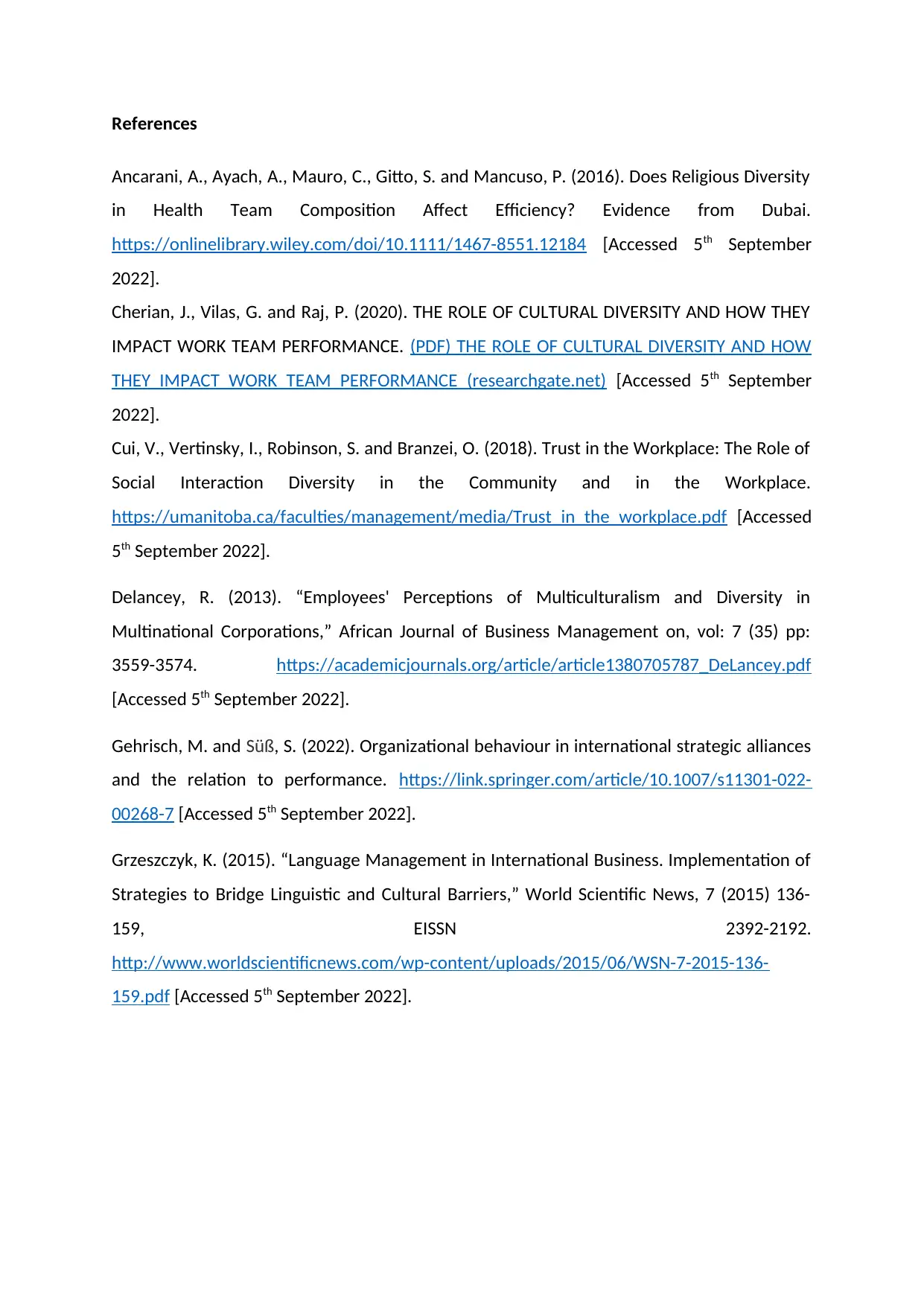
References
Ancarani, A., Ayach, A., Mauro, C., Gitto, S. and Mancuso, P. (2016). Does Religious Diversity
in Health Team Composition Affect Efficiency? Evidence from Dubai.
https://onlinelibrary.wiley.com/doi/10.1111/1467-8551.12184 [Accessed 5th September
2022].
Cherian, J., Vilas, G. and Raj, P. (2020). THE ROLE OF CULTURAL DIVERSITY AND HOW THEY
IMPACT WORK TEAM PERFORMANCE. (PDF) THE ROLE OF CULTURAL DIVERSITY AND HOW
THEY IMPACT WORK TEAM PERFORMANCE (researchgate.net) [Accessed 5th September
2022].
Cui, V., Vertinsky, I., Robinson, S. and Branzei, O. (2018). Trust in the Workplace: The Role of
Social Interaction Diversity in the Community and in the Workplace.
https://umanitoba.ca/faculties/management/media/Trust_in_the_workplace.pdf [Accessed
5th September 2022].
Delancey, R. (2013). “Employees' Perceptions of Multiculturalism and Diversity in
Multinational Corporations,” African Journal of Business Management on, vol: 7 (35) pp:
3559-3574. https://academicjournals.org/article/article1380705787_DeLancey.pdf
[Accessed 5th September 2022].
Gehrisch, M. and Süß, S. (2022). Organizational behaviour in international strategic alliances
and the relation to performance. https://link.springer.com/article/10.1007/s11301-022-
00268-7 [Accessed 5th September 2022].
Grzeszczyk, K. (2015). “Language Management in International Business. Implementation of
Strategies to Bridge Linguistic and Cultural Barriers,” World Scientific News, 7 (2015) 136-
159, EISSN 2392-2192.
http://www.worldscientificnews.com/wp-content/uploads/2015/06/WSN-7-2015-136-
159.pdf [Accessed 5th September 2022].
Ancarani, A., Ayach, A., Mauro, C., Gitto, S. and Mancuso, P. (2016). Does Religious Diversity
in Health Team Composition Affect Efficiency? Evidence from Dubai.
https://onlinelibrary.wiley.com/doi/10.1111/1467-8551.12184 [Accessed 5th September
2022].
Cherian, J., Vilas, G. and Raj, P. (2020). THE ROLE OF CULTURAL DIVERSITY AND HOW THEY
IMPACT WORK TEAM PERFORMANCE. (PDF) THE ROLE OF CULTURAL DIVERSITY AND HOW
THEY IMPACT WORK TEAM PERFORMANCE (researchgate.net) [Accessed 5th September
2022].
Cui, V., Vertinsky, I., Robinson, S. and Branzei, O. (2018). Trust in the Workplace: The Role of
Social Interaction Diversity in the Community and in the Workplace.
https://umanitoba.ca/faculties/management/media/Trust_in_the_workplace.pdf [Accessed
5th September 2022].
Delancey, R. (2013). “Employees' Perceptions of Multiculturalism and Diversity in
Multinational Corporations,” African Journal of Business Management on, vol: 7 (35) pp:
3559-3574. https://academicjournals.org/article/article1380705787_DeLancey.pdf
[Accessed 5th September 2022].
Gehrisch, M. and Süß, S. (2022). Organizational behaviour in international strategic alliances
and the relation to performance. https://link.springer.com/article/10.1007/s11301-022-
00268-7 [Accessed 5th September 2022].
Grzeszczyk, K. (2015). “Language Management in International Business. Implementation of
Strategies to Bridge Linguistic and Cultural Barriers,” World Scientific News, 7 (2015) 136-
159, EISSN 2392-2192.
http://www.worldscientificnews.com/wp-content/uploads/2015/06/WSN-7-2015-136-
159.pdf [Accessed 5th September 2022].
Secure Best Marks with AI Grader
Need help grading? Try our AI Grader for instant feedback on your assignments.
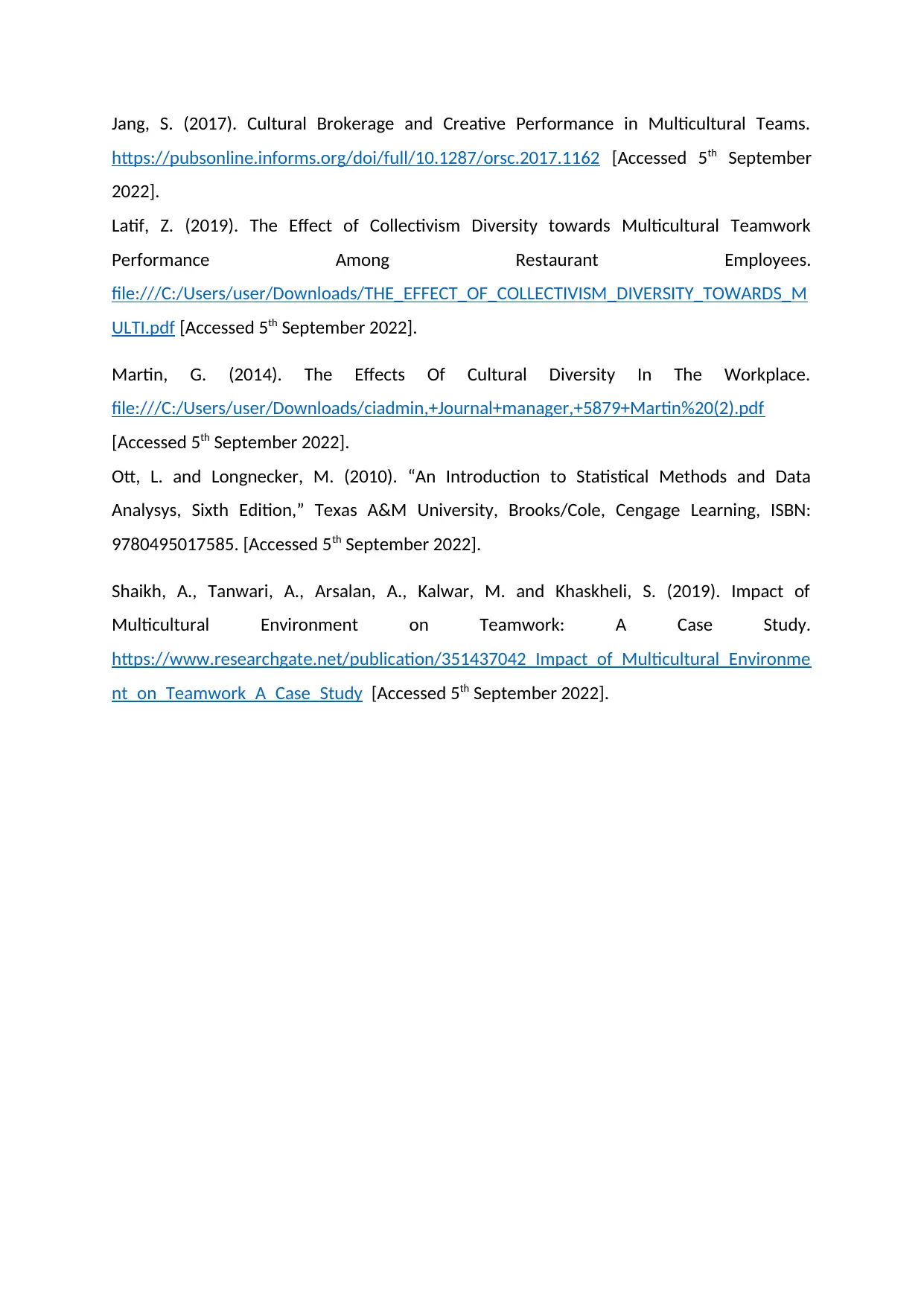
Jang, S. (2017). Cultural Brokerage and Creative Performance in Multicultural Teams.
https://pubsonline.informs.org/doi/full/10.1287/orsc.2017.1162 [Accessed 5th September
2022].
Latif, Z. (2019). The Effect of Collectivism Diversity towards Multicultural Teamwork
Performance Among Restaurant Employees.
file:///C:/Users/user/Downloads/THE_EFFECT_OF_COLLECTIVISM_DIVERSITY_TOWARDS_M
ULTI.pdf [Accessed 5th September 2022].
Martin, G. (2014). The Effects Of Cultural Diversity In The Workplace.
file:///C:/Users/user/Downloads/ciadmin,+Journal+manager,+5879+Martin%20(2).pdf
[Accessed 5th September 2022].
Ott, L. and Longnecker, M. (2010). “An Introduction to Statistical Methods and Data
Analysys, Sixth Edition,” Texas A&M University, Brooks/Cole, Cengage Learning, ISBN:
9780495017585. [Accessed 5th September 2022].
Shaikh, A., Tanwari, A., Arsalan, A., Kalwar, M. and Khaskheli, S. (2019). Impact of
Multicultural Environment on Teamwork: A Case Study.
https://www.researchgate.net/publication/351437042_Impact_of_Multicultural_Environme
nt_on_Teamwork_A_Case_Study [Accessed 5th September 2022].
https://pubsonline.informs.org/doi/full/10.1287/orsc.2017.1162 [Accessed 5th September
2022].
Latif, Z. (2019). The Effect of Collectivism Diversity towards Multicultural Teamwork
Performance Among Restaurant Employees.
file:///C:/Users/user/Downloads/THE_EFFECT_OF_COLLECTIVISM_DIVERSITY_TOWARDS_M
ULTI.pdf [Accessed 5th September 2022].
Martin, G. (2014). The Effects Of Cultural Diversity In The Workplace.
file:///C:/Users/user/Downloads/ciadmin,+Journal+manager,+5879+Martin%20(2).pdf
[Accessed 5th September 2022].
Ott, L. and Longnecker, M. (2010). “An Introduction to Statistical Methods and Data
Analysys, Sixth Edition,” Texas A&M University, Brooks/Cole, Cengage Learning, ISBN:
9780495017585. [Accessed 5th September 2022].
Shaikh, A., Tanwari, A., Arsalan, A., Kalwar, M. and Khaskheli, S. (2019). Impact of
Multicultural Environment on Teamwork: A Case Study.
https://www.researchgate.net/publication/351437042_Impact_of_Multicultural_Environme
nt_on_Teamwork_A_Case_Study [Accessed 5th September 2022].
1 out of 23
Your All-in-One AI-Powered Toolkit for Academic Success.
+13062052269
info@desklib.com
Available 24*7 on WhatsApp / Email
![[object Object]](/_next/static/media/star-bottom.7253800d.svg)
Unlock your academic potential
© 2024 | Zucol Services PVT LTD | All rights reserved.
